Den of Geek

Comparing The Three Versions of Star Trek: The Motion Picture
Is there a definitive version of Star Trek: The Motion Picture at last? We compared all the different versions of this misunderstood movie to find out.

- Share on Facebook (opens in a new tab)
- Share on Twitter (opens in a new tab)
- Share on Linkedin (opens in a new tab)
- Share on email (opens in a new tab)
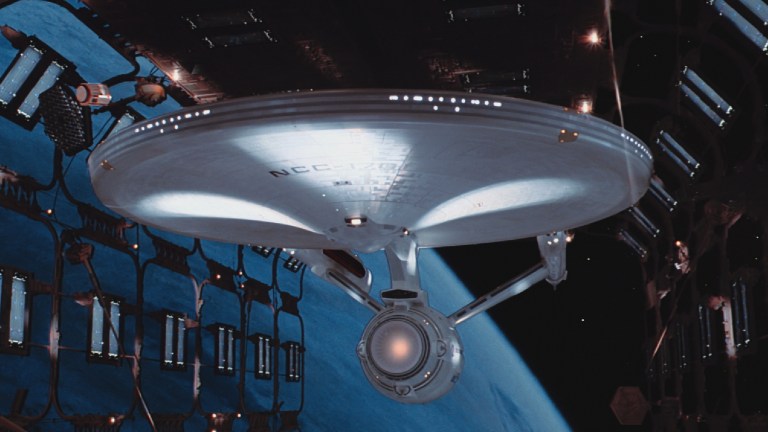
Some 44 years after it went into production, Star Trek: The Motion Picture is finally complete.
We don’t say that frivolously. Star Trek: The Motion Picture is one of Hollywood’s most famous “unfinished” films. Rushing to meet a December 7, 1979 release date, with many of the visual effects being completed right up until the last possible minute by Douglas Trumbull (who had replaced the previous VFX supervisor), director Robert Wise ( The Day the Earth Stood Still , The Sound of Music ) pretty much just stopped working on the film, carrying the first available print on a plane to the movie’s Washington D.C. premiere.
The complicated story of how ST: TMP – the first major motion picture based on an existing TV series — was developed, written, filmed, and released is a long, winding one that has been told before. It’s also well-known that the original theatrical version of the film – the one that Wise had to deliver finished or not – was not well-received by either fans or critics, although it became a sizable box office success.
Yet Star Trek: The Motion Picture steadily grew in stature over the years, gradually beginning to hold its own with fans even as later favorites like Star Trek II: The Wrath of Khan and Star Trek IV: The Voyage Home ascended to the top of the franchise.
Ad – content continues below
With fans and even critics constantly reappraising the original film, Paramount Pictures – with the encouragement of two members of Robert Wise’s production company, David C. Fein and Michael Matessino – allowed Wise and his team to revisit the movie in 2001, reconstructing it to finally adhere more closely to Wise’s original vision.
The release of Star Trek: The Motion Picture – The Director’s Edition in November 2001 on home video (DVD and VHS) confirmed for many fans that there was a far better film after all hidden inside the “rough cut” (Wise’s own words) released in 1979. Scenes were excised or trimmed, a few were reinstated, and most importantly, the visuals were spruced up with the help of CGI. The legendary Wise, who passed away four years later in 2005, got the chance to finish the movie the way he wanted.
But the story wasn’t over yet.
Star Trek: The Motion Picture Reborn
Earlier this year, Paramount+ premiered a 4K Ultra HD (high definition) version of Star Trek: The Motion Picture – The Director’s Edition . Prepared over the course of six months by Fein, Matessino, and a visual effects team with access to Paramount’s archives, this iteration of ST: TMP stayed true to the vision established by Wise for The Director’s Edition in 2001, while doing a further, extensive, HD restoration and upgrade of the entire film.
Now the Ultra HD Director’s Edition , along with 4K Ultra HD versions of the original theatrical cut and the “Special Longer Version” that was created for broadcast television in 1983, are available in a newly released set called The Complete Adventure , which gives us a definitive document of Star Trek: The Motion Picture in all three versions, looking perhaps the best they’ll ever look ( The Director’s Edition is also available on its own or as part of a set containing Ultra HD upgrades of all six films starring the original Trek cast).
Having seen the film in its original theatrical release, then on VHS, DVD, and Blu-ray, we were always put off by the seeming drabness of the image and the colors. To our eyes, Star Trek: The Motion Picture – despite the occasionally awe-inspiring visuals it did manage to pull off against all odds – never seemed to pop off any screen or medium we watched it on.
That problem is now solved, and overpoweringly so: the film in 4K Ultra HD looks absolutely magnificent, as if we’re truly seeing the film for the first time.
Get the best of Den of Geek delivered right to your inbox!
Yes, many of the VFX have been digitally enhanced or even freshly recreated, but they’re integrated almost seamlessly into the original aesthetic of the film, while many of the rough spots in the original release have been repaired or replaced. Now the 4K image really does leap off the screen in amazing color and detail. To watch Star Trek: The Motion Picture in this way is to watch a 44-year-old science fiction movie that looks in many ways like it was made last year.
And now that all three versions of the movie are here in this beautiful, pristine form, which one holds up the best and do they differ?
The Original Theatrical Cut
It may look better than it ever has, but the original theatrical cut of Star Trek: The Motion Picture still has all the issues it had when it first came out. It’s slow-moving to the point of being inert, it spends way too much time on endless visuals (the first sight of the refurbished Enterprise , the lengthy flyover of the massive V’Ger spacecraft – heck, even Spock’s neck-pinch of some poor slob guarding an airlock takes way too long), and it leaves certain plot information and character motivations ambiguous at best and absent at worst.
What ST: TMP does retain is a sense of grandeur, and occasionally a sense of wonder, that often marked the best of the original series and has been sadly lacking in so much filmed science fiction ever since, including later Trek movies and TV series.
So many of the later movies – especially the J.J. Abrams-conceived Kelvin trilogy , but some of the classic and Next Generation films have the same problem – revolve around fairly simple bad guy/revenge motifs.
The original series had its share of those simple action-adventure episodes, but so much more of it was dedicated to great ideas – whether it be truly alien encounters, mirror universes, or moral quandaries posed by the Enterprise sticking its saucer in a new planet’s business.
And yes, even though Star Trek: The Motion Picture is in some ways a rewrite of the original series episode “The Changeling,” it’s much more expansive and even cosmic in its implications. While several later Trek films are superior in many ways, few of them have matched ST: TMP in its ambitions and pure science fiction concepts.
The acting is inconsistent, to say the least, although all our old favorites each have a memorable moment or two, and the glacial pacing really is at odds with the imagination glimpsed in the storyline and the visuals. In many ways, the theatrical cut remains a slog, but it’s also a one-of-a-kind Trek movie.
The ‘Special Longer Version’
Star Trek: The Motion Picture premiered on American network television – ABC, to be exact – on February 20, 1983. Not only was this the first TV showing of the movie, but it also introduced a different cut of the film that came to be known as the “Special Longer Version.” Running for two hours and 24 minutes (without commercials), as opposed to the theatrical cut’s two hours and 12 minutes, the “SLV” essentially incorporated a number of scenes that were left unfinished and kept out of the picture by director Robert Wise in 1979 – who apparently did not approve of this version.
A lot of the scenes that were added back into the movie for the “SLV” were and are clearly extraneous, although in some cases amusing to watch.
There are a couple of exchanges between Sulu (George Takei) and the Deltan navigator Ilia (Persis Khambatta) – whose species is apparently quite sexually attractive and active – that are possibly meant to suggest Sulu is coming under her spell, although they were jettisoned to focus on Ilia and Decker’s (Stephen Collins) relationship (there is also more of that present in this cut).
Other sequences – like a moment in which Spock (Leonard Nimoy) weeps for V’Ger and a quick scene of Ilia helping to relieve Chekov’s (Walter Koenig) pain after he is injured – actually made it into the Director’s Cut and work well there as improved character moments.
Most infamously, the original release of the “SLV” contained a literally unfinished shot of Kirk (William Shatner) leaving the Enterprise airlock in a spacesuit to pursue Spock as the Vulcan himself spacewalks deeper into V’Ger’s interior. When the “SLV” was first shown, parts of the soundstage around the airlock set were still visible, as a result of the effects for the scene never being completed (the new 4K Ultra HD version of the “SLV” rectifies that, although the incomplete version is provided as a bonus feature).
Importantly, the new version of the “SLV” has restored it to its theatrical matting – the movie was cropped to the old TV screen ratio of 1.33: 1 for broadcast (and for several subsequent home video releases), turning Wise’s widescreen compositions into a nightmare of forced zooms and pan-and-scanning. At least now this version of the film is restored to its proper ratio.
That said, the “Special Longer Version” is in many ways the worst version of the film. While it’s always interesting for completists to see footage left out of a theatrical movie, this iteration simply pastes all that material back into the film – ostensibly to fill a three-hour “network movie premiere” slot, back in the day when such things mattered – without any consideration of whether it should be there. If the pacing of Star Trek: The Motion Picture has always been a bone of contention for you, the “SLV” doubles down on that.
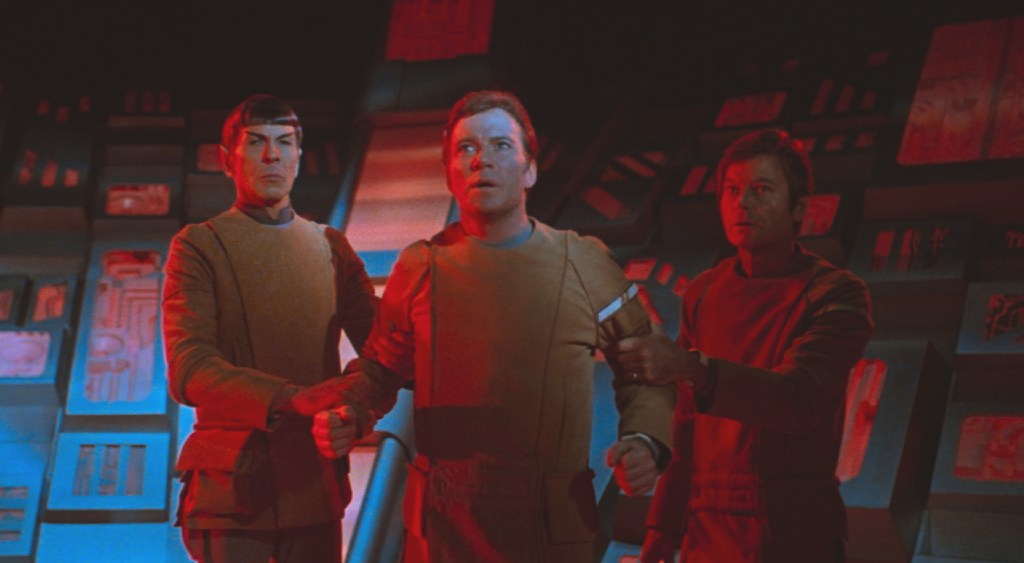
The Director’s Edition
Ironically enough, the Robert Wise-supervised “Director’s Edition” of Star Trek: The Motion Picture runs for two hours and 16 minutes – four minutes longer than the theatrical release. It also includes some of the scenes Wise left out initially, which surfaced in the interim in the TV version of the movie (a detailed list of alterations and additions can be found here ).
But while it still suffers from pacing issues, they’re less of a detriment. The Director’s Edition still moves slowly, but doesn’t feel like it drags, and there’s more of a stateliness to it that is befitting the movie’s larger themes – which are also given more clarity in this version.
Latest Movie reviews
Challengers review: zendaya scores in twisted sports thriller, rebel moon 2: the scargiver review – zack snyder definitely leaves a mark, spy x family code: white review – a radical genre pivot for a beloved anime.
Perhaps the most important edition in that sense is the scene in which Spock weeps for V’Ger – a scene that makes it much clearer what V’Ger is seeking as it returns to Earth, and why its quest has reached a potentially catastrophic dead end.
More importantly, the scene also brings Spock’s own character arc in the film into much better focus – he realizes that his desire to purge all remaining emotion from his own life (the kolinahr ritual) could lead him to the same cold, empty existence that V’Ger now faces, which he firmly rejects.
Also retained is Ilia’s healing of Chekov, adding a little more nuance to what is mostly a blank slate of a character, as well as some brief interactions between the supporting crew members.
What is left out are, most notably, the full-length travelogues along V’Ger’s exterior and interior (although we do get a neat shot of the entire V’Ger vessel emerging from its cloud above Earth). The scenes are still there, but this material – and a number of other visuals – is trimmed and sharpened to give the movie a little more forward motion. Along with that, so many subtle visual and audio touches have been added – whether it’s better matte or CG backgrounds or original sounds from the TV series – to create more ambiance and an overall more fulfilling cinematic Trek experience.
When Wise and his team took the movie back into the shop in 2001, they overhauled the visuals and the sound mix with the best available technology at the time – yet the limitations back then in terms of resolution meant that the Director’s Edition was only available on DVD for the next 20 years. With the new upgrade, all the visual and sonic enhancements (plus new ones) have been rendered so that they can now be seen in 4K Ultra HD – thus giving Star Trek: The Motion Picture the most up-to-date restoration possible.
The result is an often eye-popping science fiction spectacle that looks fresher and better than ever before. As rushed as the original production was, it’s a tribute to Wise, Trumbull, and the team that completed the film in 1979 that so much of their work still holds up and was able to mesh so well with the enhancements of both 2001 and 2021.
But just as importantly, Star Trek: The Motion Picture is now about as close as it will ever come to being the visionary sci-fi epic that it was first conceived as. The new version of The Director’s Edition retains all the narrative revisions that Wise made more than two decades ago, while adding the visual grandeur that such a cerebral story needed in the first place. Yes, there are still flaws in the film, and it may never replace, say, The Wrath of Khan at the top of Trek movie rankings, but more than four decades after it first came out, Star Trek: The Motion Picture is now finished.
This film’s journey is at last complete, but the human adventure is still just beginning.
Star Trek: The Motion Picture – The Director’s Edition – The Complete Adventure is out now on 4K Ultra HD and Blu-ray.

Don Kaye | @donkaye
Don Kaye is an entertainment journalist by trade and geek by natural design. Born in New York City, currently ensconced in Los Angeles, his earliest childhood memory is…

- View history
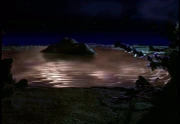
The Great Link appearing as a gelatinous sea on the Founders' homeworld in 2371
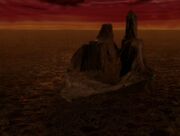
A single rock amid the Great Link on the Founders' new homeworld in 2372
The Great Link (or The Link ) was the intermingling of many Changelings in their natural liquid form, and the foundation of their society, providing meaning for the Changelings' existence. ( DS9 : " The Search, Part II ")
As the home of the Founders , the Link was effectively the "capital" of the Dominion . For millennia, the Link was located on a rogue planet within the Omarion Nebula , until it was discovered by Odo and the crew of the USS Defiant in 2371 . This led the Tal Shiar and the Obsidian Order to launch a joint assault on the Founders' homeworld , intending to wipe out the Founders and destroy the Dominion. However, the entire attack was actually a plot to weaken the Cardassian and Romulan Star Empires – the Founders had already evacuated the planet, and a fleet of Jem'Hadar fighters was waiting inside the nebula to annihilate the invaders. ( DS9 : " The Die is Cast ")
In 2372 , the Founders forced Odo to return to the Great Link, then relocated to the Founders' new homeworld , for judgment after he murdered another Changeling . As punishment for his crime, Odo's shapeshifting abilities were taken away, and he was given Human form. ( DS9 : " Broken Link ")
In 2375 , the Changeling Laas revealed that he was one of the Hundred Changelings who were sent by the Founders to gather information on the solids they encountered. Like the Founders, Laas had an established distrust of solids based on experience. However, he would set out to find the other Hundred and create a new Great Link. ( DS9 : " Chimera ")
Unknown to the Founders at the time, Odo's temporary joining with the Link had infected all of the Changelings with a morphogenic virus that began to inhibit their natural shapeshifting abilities, slowly killing them. A cure was later brought back by Odo, who single-handedly cured the entire Great Link, an event which was instrumental in ending the Dominion War . After curing his people, Odo decided to stay with the Link. ( DS9 : " What You Leave Behind ")
After the war, a faction of Changelings dissatisfied with the result broke away from the Great Link and infiltrated the Alpha Quadrant. Odo warned Worf of this, but Starfleet did not acknowledge it publicly for fear of restarting the war. One infiltrated the USS Titan -A as a saboteur to ensure that the Shrike could always locate the Titan . Another was involved in the theft of technology from the Daystrom Institute . After being interrogated by Worf and Raffaela Musiker , it attempted to escape but was vaporized by Worf. It was later revealed that this faction had allied themselves with the Borg Queen and the remnants of the primary Borg Collective . Most of the faction met their end during their failed hijacking of the Titan -A and the Shrike 's subsequent destruction. After the final defeat of the Borg, Admiral Beverly Crusher was able to come up with a way to detect the Changeling infiltrators throughout Starfleet. The remaining infiltrators were exposed and arrested and the captive Starfleet officers who they had replaced were found and rescued. ( PIC : " The Next Generation ", " Seventeen Seconds ", " Surrender ", " Võx ", " The Last Generation ")
Appendices [ ]
Background information [ ].
According to the script for DS9 : " To the Death ", when Weyoun claps Odo on the shoulder, he introduced the illness that presents itself in " Broken Link " and necessitates Odo's return to the Great Link (where Odo introduces the Section 31 virus to the Great Link ). This fact, however, is never obvious on screen.
Ronald D. Moore stated, " The Great Link rules the Dominion and I think the Female Shapeshifter has said that there is very seldom any dissension in the Link. She is not the leader and presumably they all share power jointly. " ( AOL chat , 1997 )
During production on "The Search" two-parter, there was only a verbal description of what the Great Link would look like. The actors consequently had to utilize all their professional abilities to make it credible. ( Star Trek: Deep Space Nine Companion (p. 167))
External link [ ]
- Great Link at Memory Beta , the wiki for licensed Star Trek works
- 3 ISS Enterprise (NCC-1701)
- Buy the Book…
- Reviews Hub

the m0vie blog

Following Us
- Adding Our RSS Feed to Your Gmail
- Following our Feed in Internet Explorer
- Millennium (Reviews)
- Star Trek: Deep Space Nine (Reviews)
- Star Trek: Enterprise (Reviews)
- Star Trek: The Next Generation (Reviews)
- Star Trek: The Original Series (Reviews)
- Star Trek: Voyager (Reviews)
- The X-Files (Reviews)
- X-Files Fandom Poll Form
Check out the Archives

Awards & Nominations

Star Trek – The Changeling (Review)
The first Star Trek pilot, The Cage , was produced in 1964. To celebrate its fiftieth anniversary, this December we are reviewing the second season of the original Star Trek show. You can check out our first season reviews here . Check back daily for the latest review.
The Changeling , an episode so good that they made it twice.
Sarcasm aside, The Changeling is mostly interesting for reasons outside the episode itself. It is the first contribution from John Meredyth Lucas, who would become the show’s producer towards the end of the season. Lucas took over from Gene L. Coon and is notable for being the first production staff member on Star Trek to direct an episode from his own script, with Elaan of Troyius in the show’s troubled third season. The Changeling arguably had an even bigger influence on the franchise, serving as a template for the first feature film.

Probing problems…
Okay, “template” may be a slight exaggeration. However, you can definitely feel the influence of The Changeling on Star Trek: The Motion Picture . However, that may simply be because the script to The Changeling hits quite heavily on some of Gene Roddenberry’s pet themes. It has a villainous robot outwitted by emotional humans, Kirk besting a god-like entity, and larger philosophical questions about religion and theology.
Even outside of the themes that resonate specifically with Roddenberry, The Changeling hits on a variety of other classic Star Trek tropes – from a threat leaving nothing but dead star systems in its wake through to an abundance of dead red shirts. There’s an argument to be made that The Changeling is one of the most archetypal Star Trek episode. If you were to bake a Star Trek episode from a stock list of ingredients, it would look a lot like this. For better or worse.

Melding metal…
There are a lot of good ideas here. Star Trek is a show that had a wonderful capacity to tackle big ideas within the framework of admittedly cheesy science-fiction. The idea of a robot on a visible string voiced by the control voice from The Outer Limits looking for God and the reason for existence while torturing Kirk and his crew seems to hit that cross-section pretty much perfectly. (See also: Mirror, Mirror , an episode that balances a cautionary tale about totalitarianism with goatees and evil sexy costume changes.)
The Changeling concerns Nomad, a wandering space proud sent out into the wider universe by humanity in the late twentieth century. While out there, it collided with “the other” , an unknown entity that scrambled its circuity while imbuing it with awesome power. As a result, Nomad has taken to wandering the cosmos, wiping out entire solar systems because they do not conform to its idea of perfection.

“Your line readings are a little robotic today…”
This plot set-up is interesting on a number of levels. It’s another firm rejection of utopianism. Although Roddenberry would try to turn the Federation into a utopia in The Motion Picture and the early years of Star Trek: The Next Generation , it’s quite clear that Star Trek itself rejected this train of thought. Over the course of the series, Kirk rejected the idea of a utopia in various forms – whether the totalitarian oppression in Return of the Archons or The Apple , or the idleness of This Side of Paradise .
In many ways, Nomad’s quest reinforces this rejection of utopia. Nomad is no longer seeking information for the purpose of expanding its knowledge or broadening its range of experience. Instead, Nomad is seeking perfection. Nothing on its journey measures up to perfection. Indeed, although Nomad has set a course for Earth, Kirk and his crew know for a fact that their home planet will not meet the standards of “perfection” set by Nomad.

“Well, if we kept Scotty in this shirt long enough, it was bound to happen…”
The Changeling explicitly compares Nomad to the crew of the Enterprise. Exploring the back story of the probe, Doctor McCoy notes, “It was supposed to be the first interstellar probe to seek new life-forms.” Given that Kirk explicitly acknowledges that the Enterprise’s mission is “to seek out new life-forms and new civilisations” at the start of every single episode , it seems like The Changeling invites the comparison.
However, while Nomad may have began with the same mission as the Enterprise, it deviated along the way. “Somehow that programming has been changed,” Spock reflects. “It would seem that Nomad is now seeking out perfect life-forms, perfection being measured by its own relentless logic.” In some respects then, Nomad could be read as a cautionary tale – a reminder that the Enterprise is out there to explore other worlds, not to measure them or to grade them or to rank them.

Testing Kirk’s metal…
After all, Nomad is corrupted by its encounter with a strange alien force identified only as “the other.” Spock explicitly acknowledges “the other” as an imperialist force – using exploration only as a means to that end. “The other was originally programmed to secure and sterilise soil samples from other planets,” he tells Kirk and McCoy, “probably as a prelude to colonisation.” This suggests that the Enterprise does not see its own space exploration as colonial in nature – “the other” is but a twisted reflection.
It’s also interesting to note that Nomad poses a direct threat to Earth itself. This would seem to be the first time that the crew of the Enterprise has encountered an adversary heading straight towards Earth. While the planet-eater in The Doomsday Machine had charted a course “through the most densely populated section of our galaxy” , the episode had left it somewhat ambiguous as to whether the organism was heading towards Earth.

“We really should have a procedure in place to deal with this sort of situation…”
This is an interesting twist of itself. Star Trek is a show that has been fascinated with exploring outwards, pushing further ahead – after all, there are lots of strange new worlds to visit. However, the second season has seen the ship pulling back a bit from the edge of known space, operating less on the fringes and spending more time developing the wider universe, building on the characters we already know.
Amok Time and Journey to Babel take the Enterprise to Vulcan, Spock’s home planet. Friday’s Child sees McCoy returning to Capella IV. The Doomsday Machine sees the crew encountering a sister ship. Mirror, Mirror offers dark counterparts to our crew. I, Mudd marks the reappearance of the show’s only recurring guest star outside of the ship’s crew. It seems the Enterprise is spending more time in familiar spaces this season, as interested in building up the world around our characters as it is in confronting them with new ones.

Into darkness…
When the Enterprise last encountered pieces of Earth’s history – Khan Noonien Singh in Space Seed or Apollo in Who Mourns for Adonais? – it occurred because the Enterprise had pushed out further ahead and effectively overtaken those other outward-bound travellers. The Botany Bay was moving slower, and Apollo had settled down to retire. Here, however, the Enterprise encounters a piece of Earth’s history on the way back home.
Star Trek was so fixated on outward exploration that viewers would not catch a glimpse of twenty-third century Earth until The Motion Picture – when another probe with delusions of godhood decided to return home. Indeed, the Enterprise crew made several visits to Earth’s history (in episodes like Tomorrow is Yesterday , The City on the Edge of Forever or Assignment: Earth ), but no trips to their own version of Earth. The spin-offs and feature films visited Earth more frequently, with Star Trek: Voyager making it the point of the show.

Where Nomad has gone before…
These are all interesting elements of The Changeling , but the episode feels a little overly familiar. There’s a sense that the show has covered a lot of this ground before, and will do so again. A massive interstellar threat destroying whole star systems? That’s a stock plot ingredient, from shows like Operation — Annihilate! , The Doomsday Machine or The Immunity Syndrome . Nomad’s questions of religion evoke other Star Trek plots that blend technology and religion, like Return of the Archons or The Apple .
The Changeling feels like more of a riff on classic Star Trek tropes than an episode of itself. An evil computer Kirk reasons to death? It’s been done – in episodes like What Are Little Girls Made Of? or I, Mudd . It is such a standard operating procedure that “using logic to defeat an evil computer” was only one small part of the climax to Wolf in the Fold . Even the episode seems a little repetitive itself, as Nomad wastes two separate pairs of red shirts at different point. (Nomad is so enamoured with killing red shirts that even Scotty and Uhura aren’t safe.)

“Thank goodness we won’t have to do this again for at least another decade…”
Gene L. Coon’s stewardship of Star Trek was one of the most intriguing and consistent periods of production. Coon oversaw any number of genuine classics, and more than a few episodes that are more interesting than their flaws might suggest. He is – along with D.C. Fontana – one of the unheralded Star Trek legends. Coon is a creative force that shaped the franchise as we know it only to wind up largely overlooked and ignored.
However, it does seem that Coon had his blind spots. In particular, Coon seemed quite fond of recycling familiar elements into his scripts. There are several instances during Coon’s tenure where the production team pressed ahead with a story that bore uncanny similarity to another from earlier in the show’s lifecycle. This is the second of three consecutive episodes where Kirk has to deal with an insane computer. The next episode, The Apple , feels like Return of the Archons with added biblical imagery.
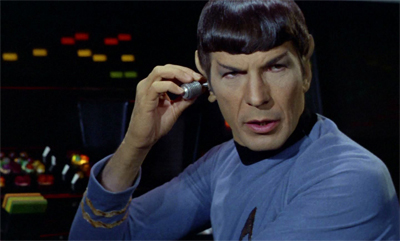
“Uhura is correct, this is surprisingly comfortable…”
There’s a reasonable argument to be made that The Changeling is more of a Star Trek mixtape than an engaging episode in its own right. As such, it makes a great deal of sense that The Motion Picture would feature a very similar plot. John Meredyth Lucas acknowledged the similarities himself in an interview with Starlog :
“The plot, of course, I recognized,” Lucas laughs. “If anything, the film proved that it’s a little hard to sustain that plot for a full movie. God knows that our effects were pretty damn good then, but are primitive today.”
This is an episode that checks all the expected boxes for a particular type of Star Trek . This is big idea-driven Star Trek , a demonstration of the franchise’s lofty science-fiction aspirations.
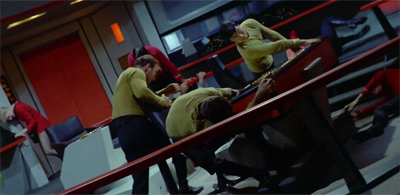
Everything is askew…
The problem with The Changeling – and the problem with The Motion Picture – is a sense that show doesn’t know what to do outside of a pretty catchy premise. A machine looking for God is a great high-concept story hook. A machine that has confused Kirk with God should be a launchpad to a more interesting story. However, The Changeling feels surprisingly lifeless. Once The Changeling has played those two (admittedly brilliant) cards, it has nowhere to go.
Nomad seems to spend most of the episode just wandering around the Enterprise causing trouble that nobody seems too worried about. It wipes Uhura’s memory, but she gets better. It kills Scotty, but he gets better. It kills anonymous security guards… and then kills more anonymous security guards. Nobody seems too bothered. Nomad floats around like it owns the ship, but there’s no palpable sense of dread as it moves, or no sense of mechanical horror to its actions.

“Don’t worry, I’m sure these two anonymous red shirts will deal with the problem…”
These problems are best illustrated during Nomad’s visit to Engineering. The probe has already killed and revived Scotty. It has murdered several crew members without so much as a second thought. The probe’s arrival should be a horrific moment. Instead, Scotty scolds the probe as if it were a misbehaving child, rather than an entity that killed him and resurrected him. “What are you doing here?” he asks. As the probe nears a vital control, he instructs, “Leave that alone.” It’s not a genocidal robot with a god complex. It’s a very naughty boy.
There is something inherently absurd about the way that Nomad moves through the ship – taking the tubolift and waiting for the doors to open – to the point where it seems like it should be whistling to itself or something. There’s nothing wrong with the design of the probe itself – which is typically impressive and in keeping the style of the show – but more to do with the way the script was Nomad wandering seemingly randomly around the ship for most of the episode.

“… if not, these two certainly will.”
And then there’s the show’s “subplot” Uhura. The supporting cast on Star Trek never really got much to do. The show was largely driven by Kirk and McCoy, with McCoy occasionally getting in on the action. It’s telling that it’s easier to think of “moments” featuring the supporting cast over the show’s three year run than it is to think about “a Sulu episode” or “a Scotty episode.” It is quite fair to argue that Star Trek only truly became a functioning ensemble with Star Trek III: The Search for Spock , which went out of its way to give most of the cast stuff to do.
This is why the amount of exposure these minor characters was such a big deal – why Nichelle Nichols and George Takei resented Shatner’s screen-hogging and line-stealing , and why Shatner could respond by suggesting their characters never had anything worth stealing. ( “They didn’t have great scenes. They didn’t have good lines. There was nothing to nick.” ) Indeed, when Walter Koenig joined the cast at the start of the second season, George Takei was originally resentful of another member of the cast competing for the limited spotlight afforded ensemble players .

Tonight, on All My Circuits…
To be fair, this was largely the style of television at the time. True ensembles were rare, and Star Trek was a show that put its leading actors in the opening credit. William Shatner and Leonard Nimoy (and, to a lesser extent, DeForest Kelley) were the literal stars of the show. Everybody else was along for the ride. When an actor like Nichelle Nichols or George Takei was unavailable, their character simply did not show up in the script. Uhura’s nature as a day player is alluded to in The Doomsday Machine , when her plot function is taken by a random and anonymous female character.
This is a perfectly understandable production reality – it’s not as if Star Trek was the worst offender on broadcast television. The other spin-offs may have felt more like ensemble pieces, but Star Trek was a product of its time. The problem isn’t so much these realities. The problem is the way that discussions of the show frequently gloss over these legitimate concerns in order to make Star Trek seem like a uniformly progressive piece of television. It was an inspirational and progressive television show in some ways, but the series had massive weaknesses and blind spots that need to be acknowledged.

Take it as read…
The second season did at least make an attempt to spread the love among the supporting cast. Although Kirk and Spock were never far from the spotlight, some of the episodes of the second season would make a point to draw in the secondary players. Wolf in the Fold saw Scotty accused of murder. Friday’s Child featured McCoy rather heavily. The Apple gives some spotlight to Chekov. Kirk remains the driving force in these plots – even McCoy is left out of the climactic confrontation in Friday’s Child – but it is a nice gesture.
So it makes sense that The Changeling should offer viewers a subplot focusing on Uhura. In many ways, Uhura is the least-developed member of the ensemble. Sulu is established as a botanist and an adventurer. Chekov is an enthusiastic young Russian nationalist. Scotty is a very wry engineer who considers the engine room to be his fiefdom. In contrast… Uhura sings. Uhura’s recreational activities involve singing, and that is only because Nichelle Nichols has a lovely voice.

“Try to out-act me, eh?”
That is pretty much the only thing that we know about Uhura as a character. Her first name would not be uttered on screen until the JJ Abrams reboot, when she replaced McCoy as a member of the leading trio. While it does mean that McCoy’s role has been somewhat been diminished in the new films, it does a lot to make Uhura a more rounded and developed character. While a portion of that character development comes from her relationship with Spock, it is still more development than Uhura received over the course of the original Star Trek .
However, Uhura’s plot in The Changeling is just terrible. Nomad hears her singing, and decides to wipe her brain, because the probe’s ability to transfer memories seems to have a “cut” function, but no “copy” command. As a result, Uhura’s mind is wiped. She is set back to “zero.” Uhura can utter a few sentences of Swahili, but has no lingering personality or memory or history. She is taken to sick bay, where she begins the painful process of re-assimilation.
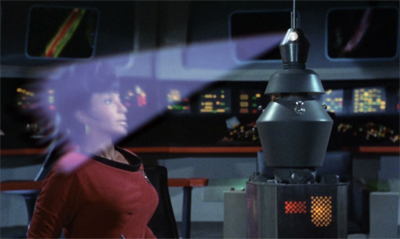
“Where is my mind?”
Except, of course, she doesn’t. Uhura is taught to read. She is apparently a quick study. By the end of the episode, McCoy informs Kirk that Uhura’s re-education has already reached “college level.” He assures Kirk, “She’ll be back on the job within a week.” There are several very serious problems with this particular plot thread. These problems are both problems of plot logic and of character development – suggesting some uncomfortable truths about how the show actually sees Uhura. (The fact that this plto thread is resolved in a throwaway line from McCoy rather than a scene with Uhura is troubling of itself.)
Most superficially, it seems to reinforce the uncomfortable suggestion that Uhura really does serve as little more than a glorified receptionist, taking and holding Kirk’s calls. To be able to go from “complete memory wipe” to “back at work” in a week suggests that the work is not too hard. It’s hard to imagine that Kirk or Spock or McCoy could re-learn everything they needed to do their jobs within a week, but Uhura’s plot functions are so generic and so basic that she can manage it

“Lighten up…”
More that that, though, the episode completely glosses over the implications of the memory wipe. Nomad forcibly wiped Uhura’s memory. That is Uhura’s entire life. It is any memory of her parents and her home life lost forever. Uhura cannot remember her childhood, her first love, her college education, her love of music, her time in the service. When she next meets an old friend, she will have no frame of reference for the conversation. Anything Uhura did not jot down in a diary is lost forever.
However, The Changeling captures none of that. McCoy never once suggests that Nomad has effectively murdered their friend – that the Uhura anybody knows is effectively dead, and a “new” Uhura has been born in her body. Instead, Uhura’s recovery is measured explicitly in terms of her ability to do her job. There’s a clear implication that Uhura’s life doesn’t exist outside her ability to perform tasks like reading and writing and opening hailing frequencies. There’s no suggestion of counselling or therapy.

Systems failure…
Let’s talk about Uhura for a moment. As a character, she’s very shallow and very poorly-defined. However, Uhura has been swept up in the mythologising of Star Trek . She is a character who has, in hindsight and in the context of the sixties, to the point where she seems monumentally important to those with even the most casual fan of Star Trek . Much as Roddenberry has done with Star Trek itself, Nichelle Nichols has worked hard to build up the legend around the character.
Uhura has been credited as being the “first major black female TV role” and being part of the “first interracial kiss.” These have become as much a part of the show’s history that they are hardly questioned or interrogated. Fans are eager to give Star Trek plaudits for trailblazing and for being ahead of the times. There are certain segments of television fans who will claim that Star Trek: The Next Generation pioneered the idea of the season-ending crossover, glossing over the existence of Cheers and Dallas .

Nomad’s gone mad…
Uhura’s importance tends to get somewhat over-played. Never mind that Uhura was ultimately more of a recurring guest star than a “major role” on the show, or that there had been major black female characters black female characters on television since the fifties, albeit in roles informed by the racism of the times . Indeed, the sixties were a hotbed for significant black characters who tend to get somewhat overshadowed by Uhura – Bill Cosby’s work on I, Spy a year before The Man Trap aired, or Diahann Carroll in Julia contemporaneously with the second season.
Even the famed “first interracial kiss” is something of an exaggeration. After all, Bill Cosby had kissed a Japanese woman in an early episode of I, Spy . It isn’t even a first within the context of Star Trek itself, as William Shatner had kissed French/Vietnamese actress France Nuyen in Elaan of Troyius , an episode produced before (but aired after) Plato’s Stepchildren . This ignores the passionate embrace between Ricardo Montalban and Madlyn Rhue in Space Seed from the first season.

A gesture of good faith…
This isn’t to undermine the importance of Uhura as an influence. Indeed, Whoopi Goldberg has talked about her enthusiastic response to seeing Nichelle Nichols on the television screen . Many African American women in science and technology have acknowledged that Uhura inspired them . Nichelle Nichols was hired by NASA to help them recruit women and minorities , which shouldn’t be a surprise – Mae Jamison, the first black female astronaut, has cited Uhura as a strong influence .
Uhura was an important and inspirational figure, but it is very easy to get swept up in the hype – it allows classic Star Trek to coast by with a reputation that it doesn’t entirely deserve. As much as the show likes to take credit for featuring a diverse ensemble, the series never did that much with the characters in question. Describing Uhura as a major character pays due respect to the place she holds in the hearts of many people, but it also paints a picture of Star Trek that is misleading and disingenuous.

Does not scan…
Perhaps George Takei himself best expresses this sentiment. In his autobiography, To the Stars , he reflects on his own struggles with his place in the larger Star Trek mythos:
I was proud to be a part of it. But I wanted to be prouder; I wanted Sulu to be doing more. My ship may have been moving steady at warp three, but I wanted to do more than merely announce that fact.
The same is true of Uhura. It’s one of the weaknesses in classic Star Trek , and one that might be excusable as a product of its time, if the series had not worked so relentless to build up its own reputation as a trailblazer.

“Don’t worry, Uhura, I’m sure the franchise’ll figure out how to write a communications officer eventually…”
There is a tendency to build a hype around Star Trek , one facilitated by Gene Roddenberry. Roddenberry after all, also claimed that he was proud of diversity on Star Trek , and created a narrative where he fought the network to preserve his idealistic vision. This version of events is so well reported that is largely accepted . In fact, the diversity was largely down to NBC :
There were many negotiations with NBC about the diversity of casting. Roddenberry had wanted a female first officer, which the network did not accept according to Solow in our interview, partly because Majel Barrett (later to be Nurse Chapel in TOS, and Lwaxana Troi in TNG, as well as the second Mrs. Roddenberry) did not work in the part. Nevertheless, NBC had a policy of encouraging a degree of diversity from which TOS benefited. The series still looks exceptional in the multiculturalism of its cast. In May 1965, NBC’s Mort Werner had sent out a directive to all network series producers to hire more actors from diverse racial backgrounds; the regular Star Trek crew had African American Nichelle Nichols,Japanese American George Takei, Walter Koenig as the Russian Chekov, and of course, Leonard Nimoy as Mr. Spock, the Vulcan, providing a regular commentary on the nature of otherness that was to become a major theme in all the series and movies and the subject of a still-proliferating flow of scholarly comment.
Although Roddenberry likes to point to the removal of Majel Barrett as an example of the short-sighted network thwarting his utopian vision, the studio seemed unhappy with the hiring of Roddenberry’s mistress for a major role in the series. It is worth noting that Nichelle Nichols was also having an affair with Roddenberry when she was cast as Uhura.

“Tell Uhura not to worry, we’ve got an anonymous extra filling in for her…”
Uhura’s plot is just a small part of The Changeling , but it remains the most significant episode of the series from Uhura’s perspective. Sadly, that is a rather damning indictment.
You might be interested in our other reviews from the second season of the classic Star Trek :
- Supplemental: (Gold Key) #1 – The Planet of No Return!
- Supplemental: (Marvel Comics, 1980) #4-5 – The Haunting of Thallus!/The Haunting of the Enterprise!
- Metamorphosis
- Friday’s Child
- Who Mourns for Adonais?
- Supplemental: Spock’s World by Diane Duane
- Supplemental: New Visions #3 – Cry Vengeance
- Wolf in the Fold
- The Changeling
- Supplemental: (DC Comics, 1984) #43-45 – The Return of the Serpent!
- Supplemental: (IDW, 2009) #13 – The Red Shirt’s Tale
- Supplemental: Deep Space Nine – Crossover
- Supplemental: New Visions #1 – The Mirror, Cracked
- Supplemental: (DC Comics, 1984) #9-16 – New Frontiers (The Mirror Universe Saga)
- Supplemental: Mirror Images
- Supplemental: Mirror Universe – The Sorrows of Empire by David Mack
- Supplemental: (IDW, 2009) #15-16 – Mirrored
- The Deadly Years
- Supplemental: (Gold Key) #61 – Operation Con Game
- Supplemental: (DC Comics, 1984) #39-40 – The Return of Mudd
- Supplemental: The Galactic Whirlpool by David Gerrold
- Supplemental: Alien Spotlight – Tribbles
- Bread and Circuses
- Journey to Babel
- A Private Little War
- The Gamesters of Triskelion
- The Immunity Syndrome
- A Piece of the Action
- By Any Other Name
- Return to Tomorrow
- Patterns of Force
- The Ultimate Computer
- The Omega Glory
- Supplemental: Assignment: Eternity by Greg Cox
- Supplemental: (DC Comics, 1989) #49-50 – The Peacekeepers
- Supplemental: (IDW, 2008) Assignment: Earth
Share this:
Filed under: The Original Series | Tagged: bill crosby , characters , divinity , ensemble , Gene L. Coon , gene roddenberry , i spy , john meredyth lucas , Nichelle Nichols , nomad , progressive , racism , religion , star trek , Star Trek: The Motion Picture , supporting cast , the changeling , the motion picture , tos , Uhura |
4 Responses
Cool. I really enjoy your thoughtful reviews. Question: Do you know if any of the novels or other expanded universe material ever followed up on Uhura’s dangling plot thread from this episode? I’ve always assumed that somehow those memories got restored (because seriously, none of her subsequent appearances make much sense if that isn’t true), but we’re never told how. It seems like an obvious basis for a new story, but I’ve never heard of anyone doing it.
I am afraid I don’t know. But I can understand not wanting to touch that plot point with a ten-foot pole.
I’m not sure I agree that Uhura’s value was reduced to that of the help and her personhood was ignored. Yes, it seemed Nomad put her brain in a developmental state below that of a new born baby’s, but why were they able to get her up to the college level before the credits even rolled while a baby needs 2 decades to progress that far? And remember how she instinctively reverted to Swahili? It seems me that this wasn’t a matter of her brain being reformatted but just all her files being deleted and McCoy’s job was to painstakingly undelete them (the most demeaning aspect of that being that her brain has a file system as primitive as FAT) and at the end of all that, they’d have *all* of Uhura again.
Also, I don’t see this episode as being just more of the tired Humanism you see in all those other episodes (which includes more than just the Apple and the Archons). It could apply to religion, but it seems to go beyond that to anyone concerned w/perfection and the price paid for it, like in Way to Eden.
Leave a comment Cancel reply
This site uses Akismet to reduce spam. Learn how your comment data is processed .
Recent Posts
- 373. Pirates of the Caribbean: The Curse of the Black Pearl (#225)
- 371. Poor Things (#246)
- 370. Dune: Part Two (#12)
- 369. Memento (#57)
- 368. Monty Python and the Holy Grail (#154)
Recently tweeted…
- "I Simply Am Not There": The Existential Horror of Eighties Excess in "American Psycho"...
- Star Trek: The Original Series (Reviews)
- Crime and Pun-ishment: The Art of the CSI One-Liner
- "They Are Touching Things!" The Aviator, and the Yearning for Human Contact...
Available at…

Blogs Well Worth Your Time
- 1001 Must See Films
- Andrew at the Movies
- Anomalous Material
- Cut the Crap Movie Reviews
- Encore Entertainment
- Fandango Groovers
- FlixChatter
- Four of Them
- It Rains… You get Wet…
- Jameson Cult Film Blog
- Jar Watches Films
- Let's Go To The Movies
- M. Carter at the Movies
- Marshall and the Movies
- Movie News First
- Musings from a Man Lost in La Mancha
- Never Mind Pop Film
- Paragraph Film Reviews
- Roger Ebert's Journal
- Ross v. Ross
- Scannain.com
- Screenwriter (Donald Clarke, Irish Times)
- Strange Culture
- The Film Cynics
- The Pompous Film Snob
- The Projection Booth
- Things That Don't Suck
- Too Busy Thinking About My Comics
- Undy a Hundy
Film Nerd Resources
- CinemaBlend (News)
- Internet Movie Database
- Rope of Silicon
- The Guardian Film Blog
- James Berardinelli
- Roger Ebert
Email Subscription
Enter your email address to follow this blog and receive notifications of new posts by email.
Email Address:
Sign me up!
Blog at WordPress.com. WP Designer.
- Already have a WordPress.com account? Log in now.
- Subscribe Subscribed
- Copy shortlink
- Report this content
- View post in Reader
- Manage subscriptions
- Collapse this bar

- April 26, 2024 | Michael Dorn Wanted Armin Shimerman To Play The Ferengi That Worf Killed In Star Trek Picard
- April 26, 2024 | Podcast: All Access Gets To Know The Breen In ‘Star Trek: Discovery’ 505, “Mirrors”
- April 25, 2024 | Prep Begins For ‘Star Trek: Strange New Worlds’ Season 3 Finale; Cast And Directors Share BTS Images
- April 25, 2024 | Jonathan Frakes Sees Opportunities With Streaming Star Trek Movies, Weighs In On “Filler Episodes”
- April 25, 2024 | Recap/Review: ‘Star Trek: Discovery’ Reflects On Its Choices In “Mirrors”
12 Most Fascinating Updates For The 4K ‘Star Trek: The Motion Picture – Directors Edition’
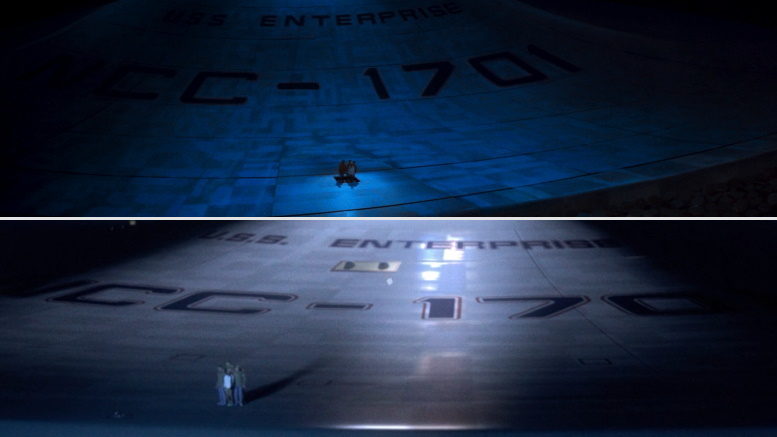
| May 25, 2022 | By: Drew Stewart 47 comments so far
After more than two decades, Robert Wise’s Director’s Edition of Star Trek: The Motion Picture has been remastered in 4K HDR, which debuted last month on Paramount+ (see TrekMovie review ). This week, it has returned to the big screen via Fathom events, with the final screenings being held Wednesday night.
TrekMovie has partnered with Drew Stewart, the man behind the Star Trek TMP Visual Comparisons Twitter account , to put together a sampling of what we see as some of the more interesting differences between this new 2022 streaming version in comparison to the 2001 DVD release of the Director’s Edition (TDE) and the 2021 HD 4K Blu-ray release of the Theatrical Edition (TE) of the film. Note all the images can be enlarged for even more detail.
The opening titles
The original opening credits were plain white as they were only supposed to be temporary. For the DVD, the original plates were scanned in as the base for the new gold version. The credits were recreated from scratch for the 4K, and now have sparkles around the edge.
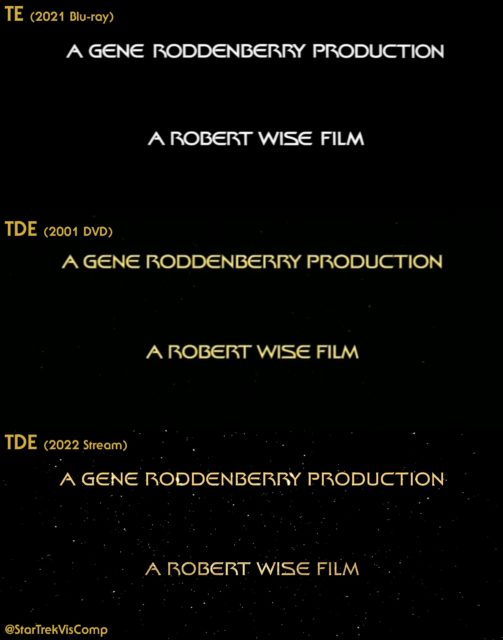
Vulcan has no moon, Miss Uhura
The original matte painting that showed night on Vulcan with moons visible was replaced by a new digital matte painting that corrects the time of day to match the live action shots and removes the moons that TOS established Vulcan does not have. Another new more detailed digital matte was created for the 4K version.
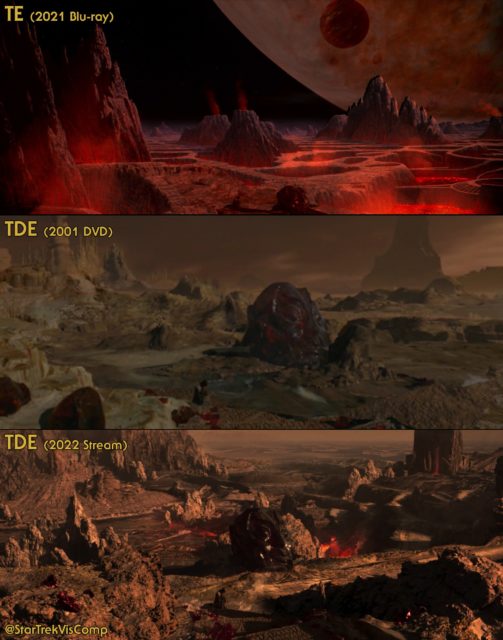
Take me over, please
This shot of the Office Complex was recomposited from the original elements (with a new starfield). A CG shuttle pod was added to the port at the bottom left.
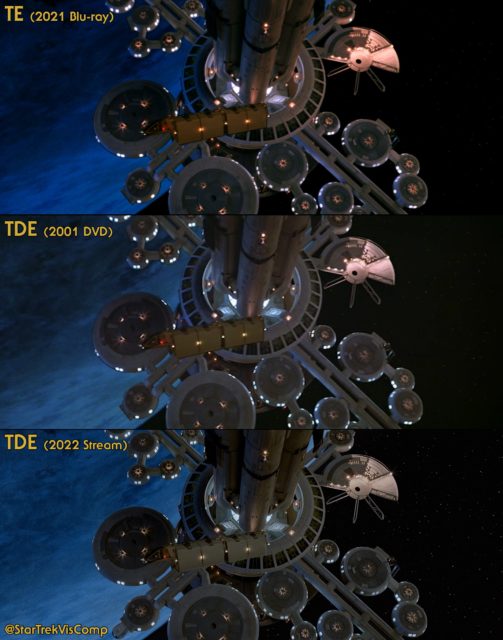
The new shot replaces this random shot of an explosion with the stage ceiling visible. This shot was recreated using an original optical VFX plate with a new CG Enterprise and a different explosion from the 2001 version which reflects against the hull.
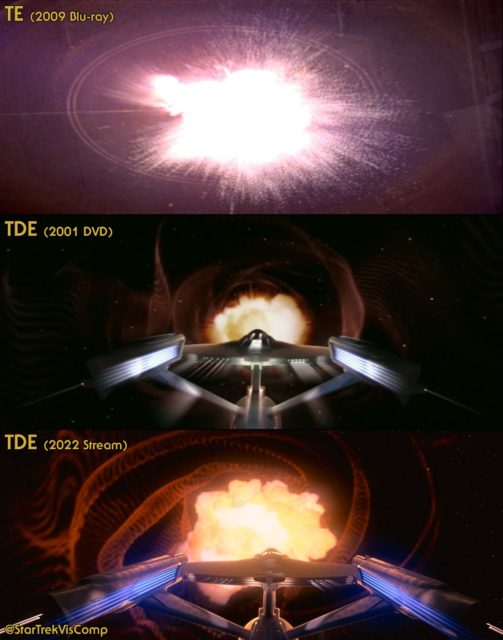
Officer’s Lounge
A nacelle was added to the original window for the 2001 version. The 2022 version removed the entire wall and replaced it with a new matte of the Officer’s Lounge window with a CG nacelle in view.
V’ger’s rings
A new shot was created for the 2022 version, which provides continuity with the next shot where Spock has rings flying behind him before he reaches the original rings. This new shot also shows the tunnel between the orifice and the V’ger Island, perhaps making the rings the entrance to the “imaging chamber” part.
V’ger emerges from the cloud
The original shot of the V’ger model approaching Earth was replaced with a new CG shot of the cloud dissipating as the camera pans towards Earth. This shot was recreated for the 2022 version.
An all-new CG exterior shot of the Enterprise going through the tunnel was created. This shot was recreated for the 2022 version.
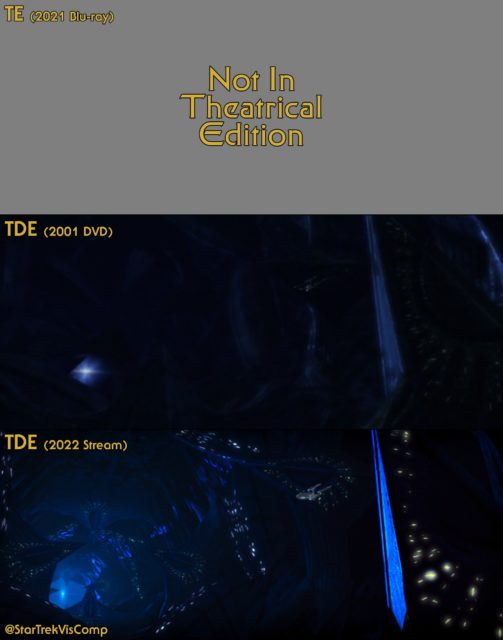

The path to V’ger
The shot of the away party coming out of the hatch to stand on the saucer was replaced with a CG version of the same actions, almost perfectly down to the timing of the movements from the original plate. The tiles now appear in front of them one-by-one, animated on the two’s to emulate the feeling of using 70’s animation techniques in 2001. The 2022 version animates every frame.
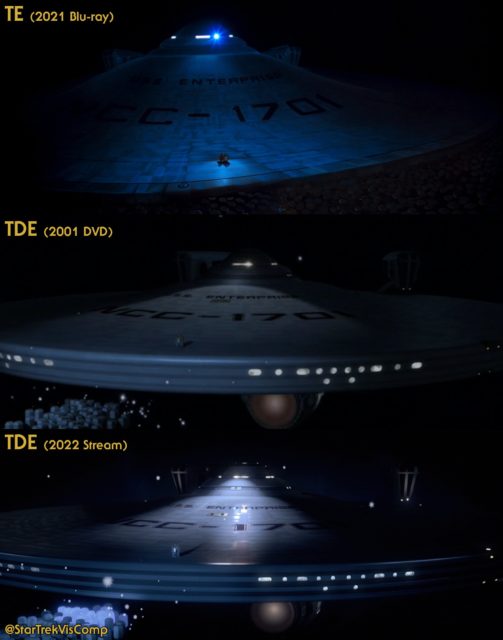
V’ger must evolve
An almost 6-second addition was made showing the entity of V’ger ascending, then imploding. This shot was recreated for the 2022 version, which puts the ship head on instead of in profile.
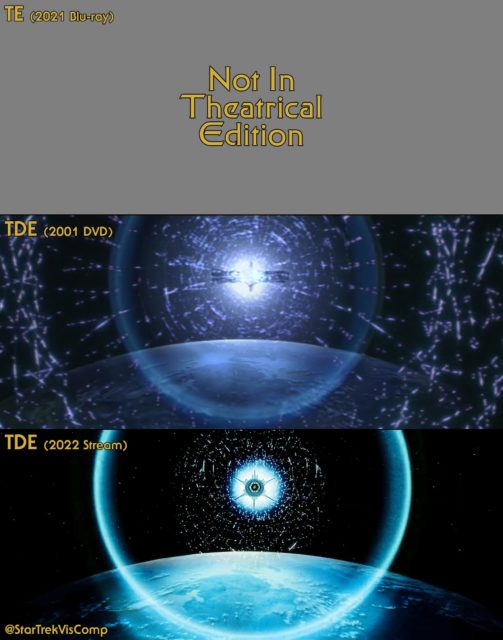
I believe I’m wearing your jacket, Doctor
Originally, Spock and McCoy’s jackets were switched in this shot. For the 2022 version, the bands on their arms were swapped back to get rid of this continuity error.
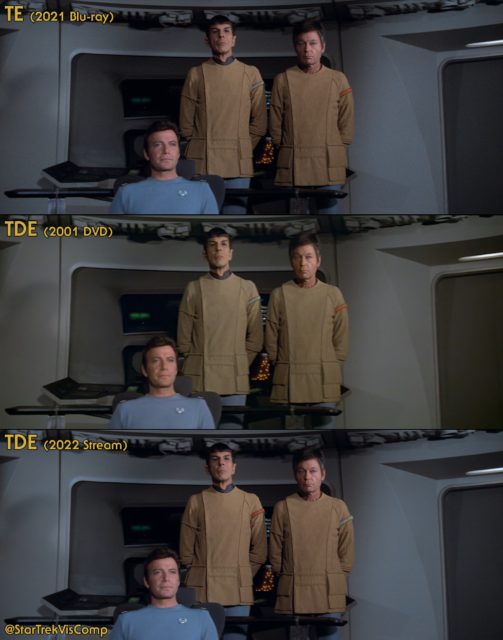
A full comparison gallery with more than 100 images and analysis can be found on Google Photos .
In addition to his work on the various iterations of Star Trek: The Motion Picture, Drew’s blog Star Wars Visual Comparisons also contains a forensic analysis of the many versions of the original Star Wars trilogy.
Last chance to see on the big screen
Star Trek: The Motion Picture returned to the big screen this week, with showings on Sunday, May 22, Monday, May 23, and Wednesday, May 25 by Fathom Events. Tickets are on sale now at fathomevents.com.
Here is the official trailer from Fathom events.
Find more news about Star Trek: The Motion Picture at TrekMovie.com .
Related Articles
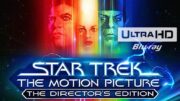
DVD/Blu-ray/Streaming , Feature Films (TMP-NEM)
Review: ‘Star Trek: The Motion Picture – The Director’s Edition’ Stuns On 4K Ultra HD Blu-ray
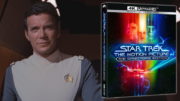
‘Star Trek: The Motion Picture’ Directors Edition 4K UHD Blu-Ray And TOS Movies Collection Coming In September

Conventions/Events/Attractions , Feature Films (TMP-NEM)
Reminder: ‘Star Trek: The Motion Picture – The Director’s Edition’ In Theaters Starting This Weekend
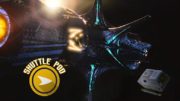
Feature Films (TMP-NEM) , Shuttle Pod
The Shuttle Pod Examines ‘Star Trek: The Motion Picture – The Director’s Edition’
The scale is still off when they’re standing on the hull of the Enterprise. The front of the hull should be a lot deeper giving the impression of multiple decks compared to their body height.
Indeed, they appear to be huge compared to the windows on the rim of the saucer.
Yes, that’s the first thing I noticed in that scene, 43 years ago. It’s a blatant error in scale and I don’t understand why they didn’t take the opportunity here to fix it.
Star Trek has never had a problem playing loose with scale. They often go with what looks good on screen, not necessarily what would be accurate.
Agreed. The ship is the WRONG SIZE. Proof that TMP is NOT in continuity! It’s clearly in its own timeline!
Yeah, but this is just slightly off scale. It’s not like having a turbolift shaft that can fit the entirety of Wembley Stadium ala Discovery.
It looks fine in the distance shot. This close-up is a bit misleading.
I think you guys are way over-analyzing this. This looks damn good compare to the original version distorted geometry.
They did a tremendous job to finally get that sequence looking about right. Time to declare victory and move on.
Yes and the windows are still too large on the cgi E
I saw it on the big screen this week and it looks fantastic, especially the exterior of the Enterprise and V’Ger interiors. Kirk’s exterior inspection of the Enterprise while in drydock was beautiful. What a joy to revisit this again on the big screen. The only cons were that I found the lounge scene and the V’ger must evolve scene a bit distracting because of the rotoscoping in the lounge, and the positioning of the ship in the starburst. Plus there were quite a few new sound effects not present on previous versions. For the casual viewer it won’t be an issue but it might be distracting for die hard fans of the film as they tend to stand out. If you are a fan of this film, this is highly recommended.
I don’t agree. I thought this had some of the same problems that Nolan’s digital transfer and cleanup of 2001: A Space Odyssey had/has – except Star Trek has ’em in spades. I saw this on a laser projection in a premium Los Angeles theater and there are a lot of problems mastering and restoring to 4k television when it translates to projection in the space of an auditorium.
Whites are stretched so thin and without detail such that in the theater all you see is the texture of the Scotch-bright screen in that space. Often the extreme perfect focus of unimportant elements on the screen is like a knife in the eye. Many of the models (the office space station primarily) do not have the level of sophistication of the Enterprise and were never meant to be presented with the amount of clarity and sharp focus that Paramount introduced. The model looks cheap and is a distraction when cutting to and from the Enterprise which is in a soft focus from the dispersion of light from the condensation between the lens and the model on the chilled stage – by design.
The glaring scale and proportion mistakes in the 4k maneuvering is even more pronounced in the theater – it actually seems to be much worse than the original theatrical which I saw a few years ago in a theater.
That briefing/lounge room for me has always been a mess starting with the layout of the set and how that space was shot – it just seems a technical stunt rather than a compelling setup where the tensions between the 3 are reflected in the staging. Every time they try to fix it it just gets worse – and it looks worse in the theater – who thought that was even possible?!
V’ger? Let’s face it the model and the hiding of the model with clouds and laser/smoke effects and all the rest is just a mess. None of it needed or could be improved by sharpening it and improving the detail – its just bad in a theater. The real tell for me was that when V’ger enters our solar system, NONE of the lighting of anything changes with the presence of the sun. If anyone ever intended the audience to see those nonsensical models and smoke that would have been the moment to pull the curtain back… it was enough that anyone was ever able to cut all the disconnected models into something that looked like the Enterprise was moving through it…
I sure did enjoy hearing Goldsmith’s score in an auditorium again, though it’s a stunner. Not so much for the improved soundeffect and soundtrack… why? why?
I think for me, now, this movie is like what a sports fan looks for in a stadium – there’s a couple of incredible moments that you anticipate and thrill at, but the rest of it isn’t really worth mentioning – just slow, uneventful stuff when you can focus on your snacks and choosing a good time to go to the bathroom.
I also saw it on a Big screen in LA this week, and I pretty much disagree with every single point you have made. All the subtle changes they made both in 2001 and for this version have substantially improved the enjoyment and appreciation of this movie for this Trek fan. And finally “seeing” V’Ger the ship — what a treat, and I thought it looked great. And the proportions are improved drastically from the theatrical cut.
And the briefing lounge scene is still hamstring form the source material, of which some key film components for that scene are lost forever — the producers covered this in the Q&A session following the LA showings.
You a entitled to your opinion though…IDIC
Look, we should all be impressed he’s even still alive and able to complain after taking so many knives to the eyes.
Exactly! LOL People just need to relax and enjoy this improved movie, and thank these dudes who have been working for years to try to get this close to what Wise would have liked to do had he been given the 6 more months he needed in 1979.
100% agree. Saw it in LA Monday night on the big screen…WOW!
Yes the still shot of the lounge redo looks like some bad roto work and the new background needs softening to match the original plate
In the theatrical version, they talked about the cloud dissipating around V’ger. I didn’t see it in the theatrical version or even the V’ger ship. It was nice to see in the 4K version. Film looks great!
Great feature here, nice work on the comparisons. I really enjoyed watching the 2022 version with all the ‘upgrades.’ Really sharp.
“ A new shot was created for the 2022 version, which provides continuity with the next shot where Spock has rings flying behind him before he reaches the original rings.”
There’s an audible reason for this change as well. Watch the scene without that added CGI and listen to Jerry Goldsmith’s score. Note how in all previous versions of the film, there is a small portion of the score that is cut out. In this new Director’s Edition, the score finally plays in full thanks to the added time that this new CGI shot provides. Mike Matessino even stated that for this new Director’s Edition the music was edited first and the film was edited to it. I would conclude this CGI shot was done because of the new music edit rather than provide any visual “continuity” between shots.
i’m glad someone else caught that! it had bothered me about earlier versions, that there was that short cut in Goldsmith’s score… it’s one of my favorite bits of it, and the cut always bothered me. so it was a nice kick, in the cinema on monday, to realize they had created the time for those few measures.
I saw it on Saturday, a full-circle reunion with my younger self who first got to see it on opening day in 1979. Still full of awkward moments re-introducing the TOS characters in its first half, the movie only really begins to achieve anything like liftoff after Persis Khambatta gets zapped, at which point it becomes a decent exploration of various SF tropes. But, for my money, it will probably never look or sound better than it does right now.
“But, for my money, it will probably never look or sound better than it does right now.”
It only took 43 years.
Now where’s my “digital restoration”?
Isn’t that a ‘space-matrix restoration coil?’ I seem to remember there being a voice-over or computer voice mentioning that.
The change I don’t like is in the audio… The anemic red alert klaxon (I guess repeated… pre-peated? …here from Wrath of Khan when Enterprise raises its shields) during the wormhole and Ilia-zapping energy probe sequences. It’s so tinny and digital and wimpy compared to the downright terrifying klaxon from the 1979 and 2001 versions.
Agreed. I posted this (we have the same name) here yesterday on another thread.
Absolutely agree as well. I also miss the computer voice when Kirk first boards the Enterprise (Attention launch crew, travel pod available at cargo six), and when Kirk walks over to Engineering to talk to Decker (Engineering to all decks, auxiliary power test in 3 minutes) and also the Ilia probe sonic shower scene. That voice so much added to the atmosphere of the scenes… Not sure how to put this, but it’s like it gave the Enterprise a soul…
Yes! “Pod secured. Pressure equalized.” I miss that voice too!
The arm band swap was not a continuity error, it was a prank by Nimoy & Kelley!
Shoulda left it alone. And neither are here to point out it didn’t need fixing.
It’s just not for me. I respect and appreciate what they were able to do originally. Let it stand as that. This obsession with upgrading and tweaking everything to conform to todays standard just takes away from that in my opinion.
I respect that opinion, I just think in this case it’s a grey area considering the film’s unfortunate circumstances. It didn’t even get to live up to 1979 standards when it was released, and the lovingly-made 2001 edition was falling into obscurity as an SD curiosity fans would have to seek out in a dying media format.
This still feels like a respectful and artfully made interpretation of Robert Wise’s preferred cut, futureproofed so his vision is accessible to everyone. We’ll always still have the theatrical cut.
As long as it doesn’t become the only version i can view it as a Special Edition, you can own both versions unlike with Star Wars, where you can only buy the 2020 Special Edition in 4K.
The Officer’s Lounge change was abysmal on the big screen in 4K.
Yeah, the screencap here looks awful! Why couldn’t they leave that with the smaller window like version 1 or version 2. goodness me.
I didn’t see the Q&A where they yalked about how difficult that was to do with what they still had to work with, but it does strike me as being a better compromise to just leave the window as is and stick the nacelle in the corner. Less to roto while still addressing the perspective issue.
I love the attention to detail and love that flew into this new version! I hope the tng films will also begin released in 4k (blu ray) soon!
For me the coolest new Enterprise VFX shot was the distance shot of the tiny E coming out of the back end of V’ger and doing a 180 degree turn…I nearly wet my pants on how cool that was to see.
Saw in on the Big Screen Monday in LA. So glad that I did not watch it on streaming first. In fact, now I am not going to watch it again until I get the 4K Blu-ray…don’t want to cheapen my viewing experience with the limitations of streaming quality.
The jackets one is kind of a big deal- an actual on-set goof corrected.
Spike’s Star Trek site has a whole list of uniform goofs. How many can be corrected now?
As someone who remembers sitting in the theater when this film was released the first time – this re release was for me a surreal experience. I still vividly remember my emotions as we all shared Kirk’s pride & joy when our beloved Enterprise appears on screen the first time. This new version looks amazing – sounds amazing – and on the big screen as it should be — savored – absorbed – amazed — this is why Star Trek is a world that will entertain for decades to come – so special
I’m sorry but for something that’s been talked up as the “definitive” version that they worked on for so long, there are still far, far too many errors and bad decisions in this thing. I went over them in detail on the original post following release, but let’s recap:
- Lounge scene, atrocious
- Matte lines around K’tingas – seriously, they could’ve erased them frame by frame with meticulous detail, but they didn’t, and it’s literally the first effects shot in the film and it’s unedited
- The sparkles around the titles are ridiculous
- Honestly the sound mix doesn’t sound as dramatic, as pointed out by several commenters here
- There is STILL some dust in the lens on the Enterprise departure sequence that absolutely should’ve been erased
- The CGI V’ger torpedo shot just doesn’t really match the original effect, and was more effective on the DVD release compared to the way they handled it here
I will appreciate all the incredible things they DID manage to do, including a lot of the ones outlined in this post which I didn’t even realize, but it’s still not perfect enough for my taste, and I demand perfection, dammit! :D This is my favorite Trek movie and I was hoping I would finally have no nitpicks, but there are some truly grating things about this release that I find means that some amalgam between this, the DVD and the original release is my “favorite” version of the film. I would love to be given all the time and money to make my own version of the movie, and see what fans think – I bet it would impress.
The Matte Lines around the Klingon ships really should have been cleaned up. It’s the opening shot of the movie and should have been pristine. It would have better served the film to not waste precious time on the lounge scene and invest it in cleaning that opening shot.
The rest of stuff you list I’m fine with…well…except for those sparkles. They are extremely amateurish looking.
If there was one other thing I would like to see better balanced is the matching of grain on the CGI to the original footages. Some of it really jumps out as CGI…especially the shot of the vger vessel at the end when it becomes pure energy. That shot looked very poor compared to the 2001 DVD. I think they should have executed that one the same as they did in 2001.
Is it confirmed the 4K disc will come with a blu-ray? in a combo pack like the theatrical 1-4 box set.
Saw it back in the late 80s on VHS and I remember feeling stunned by how cold this movie was, and how removed the characters were from their Original Series selves.
Coming back to it now, I can visibly see the improved audio and corrected color palatte (as well as a sharper overall image) has changed things for the better. The movie looks and feels closer to what was originally intended: a post-Original Series episode made for the big screen. The leads (Kirk, Spock, McCoy, etc) are grounded, and the crew and ship around them are livelier. The mixed bag here may be V’ger, which has lost some of its coldness, but has gained complexity as a character.
Some of the old story problems remain here however. It still takes forever for this movie to get started and we all know the scenes I’m talking about.
We have to concede some of our current disappointment may lay in the fact that, having seen this movie before, the mystery about what V’ger is, is gone. Kind of like re-watching the Sixth Sense. Still, a solid three abd half stars.
I just managed to watch this in the UK. I had to raise the jolly roger in the end to get it.
It’s a strange thing this version. First off, like the original Directors Edition, I love the changes to the editing, it really improves the watchability of the film.
However some of the changes in this version, and some things that weren’t changed, are quite puzzling. To start off the new sparkly titles are awful, embarrassingly awful. Then we jump in to the Klingons attacking V’ger and there are the same old ENORMOUS matte lines, we also see loads more matte lines throughout the rest of the film, including the weird matte effect around the lights on the space dock scene – surely in 2022 we could have got those taken care off.
Speaking of the space dock scene, it’s a strange thing but for the first time ever watching this film the Enterprise looked like a model. To me it’s always looked like a real enormous ship but from certain angles in this version it looked model like. I don’t know if it’s because it’s in 4K but it’s the first time I ever thought that.
Then the other thing that really took me out of the film was the V’ger spacecraft itself – it really looked like bad CGI, it didn’t fit at all with the look of the rest of the film, and the head on shot at the end when it is just about to disintegrate just made me laugh. it was a genuine “WTF is that” moment.
Finally, the officers lounge scene. What on earth were they thinking? They should have just kept the original shot.
What I did like was the new sound mix, I found the dialogue and effects were much more intelligible and nicely separated from the music, although I missed some of the ship based announcements which were much quieter. As others have mentioned I didn’t like the new red alert klaxon.
I know it sounds like I hated this but I didn’t at all. I’m really, really, glad they did it and it’s the best this film has ever looked but I wish they had spent much more time cleaning up what we already had than creating new stuff that didn’t quite fit in.
Did they trim a substantial portion of the 10+ minutes of the Enterprise’s rendezvous with destiny, as it flies into Vger’s gaping maw?
I prefer to think they flew up its butt.
Has anyone else noticed that there is a new computer display animation on the Epsilon 9 control station monitor that reveals the Klingon attack under way? It shows the 3 vessels in the tactical display, and one of them winks out of existence. I don’t think this imagery appeared in the previous versions. Rather, we saw the visuals for 2 of the 3 Klingon vessels getting destroyed. This image on the computer monitor sort of completes the narrative structure. I thought it was a deft addition.

Midnite Reviews
Detailed analysis of classic sci-fi movies and tv shows, star trek episode 32: the changeling.
Technical Specs
Director: Marc Daniels
Writer: John Meredyth Lucas
Cast: William Shatner, Leonard Nimoy, DeForest Kelley, James Doohan, Nichelle Nichols, George Takei, Majel Barrett, Blaisdel Makee, Barbara Gates, Meade Martin, Arnold Lessing, and Vic Perrin
Composer: Fred Steiner
Air Date: 9/29/1967
Stardate: 3541.9
Production #: 60337

(Spoilers beyond this point)
While Scotty’s resurrection seems a tad unrealistic even by science fiction standards, Uhura’s ability to recover from a total mind swipe borders on the absurd.
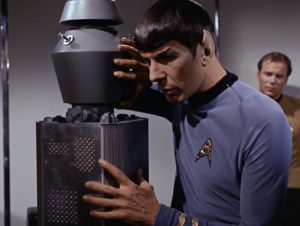
Concluding Comments

Overall Quality: 9/10
If you enjoyed this post, please click the follow button or enter your email address in the subscription box to stay tuned for more updates.
- More to Explore
- Series & Movies
Episode Preview: The Changeling
Let’s Watch Star Trek

[TOS] The Changeling
[TOS] Season 2, Episode 3 (Netflix: S2 E3): The Changeling
Aside from some interesting thematic and plot-related similarities to The Motion Picture, The Changeling doesn’t offer anything particularly unique or exciting.
Read more at Memory Alpha
Enterprise is taking fire from something! Spock said each blast packs the punch of 90 torpedoes and they can take 4 hits. Enterprise can withstand 360 torpedoes?
They beam the culprit over and it’s a robot probe named Nomad
Nomad thinks Kirk is its creator
Nomad scans Uhura’s head. It says she’s defective and has chaotic thinking and is a mass of conflicting impulses. Take it easy Nomad
Nomad zaps Scotty! Scotty’s dead?
Don’t worry, Nomad repairs Scotty
Nomad says it wiped Uhura’s memory!? No one seems that worried about it. They just say they’ll reteach her everything. Some memories can’t really be retaught. She still seems to know Swahili, maybe she remembers some stuff
Spock does a mind meld with Nomad
Nomad had the mission to find new life but it combined with another probe it came across that had a mission of sterilizing soil. So now Nomad eliminates all life that isn’t perfect!
Kirk says it’s like a “changeling”: a fairy that would assume the role of a baby. Ehh, it’s not really like that
Nomad stops by engineering and makes them go warp 11
Kirk talks Nomad into destroying itself, which is how something like 90% of bad computers die.
<Previous Episode ——————————————————– Next Episode>
Share this:
Star Trek (TV Series)
The changeling (1967).
- User Reviews
Awards | FAQ | User Ratings | External Reviews | Metacritic Reviews
- User Ratings
- External Reviews
- Metacritic Reviews
- Full Cast and Crew
- Release Dates
- Official Sites
- Company Credits
- Filming & Production
- Technical Specs
- Plot Summary
- Plot Keywords
- Parents Guide
Did You Know?
- Crazy Credits
- Alternate Versions
- Connections
- Soundtracks
Photo & Video
- Photo Gallery
- Trailers and Videos
Related Items
- External Sites
Related lists from IMDb users

Recently Viewed
- The Inventory
The Beautifully Dull Paradox of Star Trek: The Motion Picture , 40 Years Later
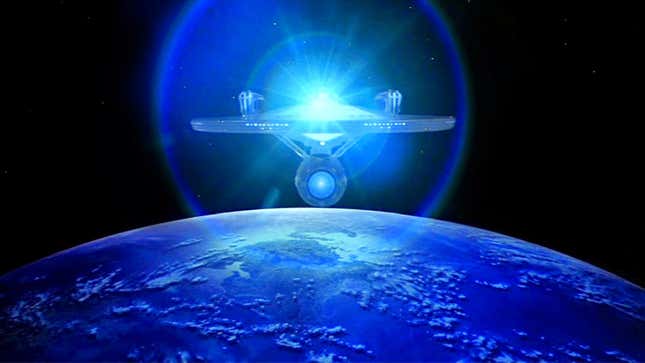
Forty years ago a landmark moment in Star Trek ’s history arrived, in the form of Star Trek: The Motion Picture . It’s an important chapter in the series’ survival, the turning point from canceled cult classic to enduring icon of science fiction. But there is a reason we remember The Motion Picture ’s place in history more than we remember The Motion Picture : I t’s boring as all hell.
Related Content
Related products.
As fans across America prepare to revisit TMP this month in celebratory screenings ahead of its actual 40th birthday this December, what they’re about to re-experience is a moment in history that is perhaps best remembered as such than for what it actually is. The Motion Picture ’s existence is paradoxical. It’s both an important moment to be remembered, and a movie so cosmically overwrought and forgettable that to contemplate seeing it again in the dark environment of a movie theater once more is to challenge your eyelids to an existential test of endurance.
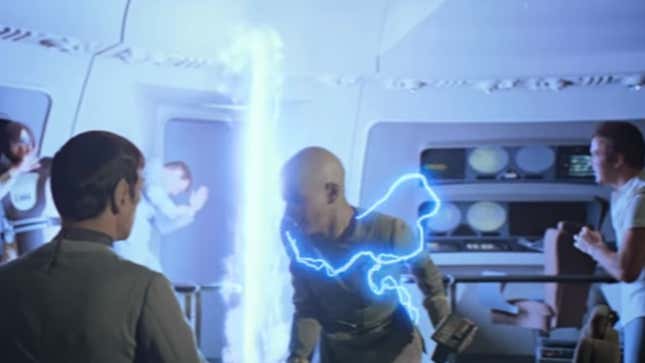
It’s why it’s so easy to remember The Motion Picture —helmed by Robert Wise, who also directed The Sound of Music and West Side Story— within the context of history and the far better things it would pave the way to. Its release proved an appetite for more Star Trek that would not just spawn an entire movie franchise beyond it, but lay the ground for Trek ’s return to TV in the form of The Next Generation , securing the franchise’s place in pop culture history for the next 40 years (and beyond).
We get to see the first dramatic steps in a transformation of the Klingons from uncomfortable Orientalist imagery into an intricate, textured culture that would make them one of the most iconic aliens in sci-fi. In newcomers Will Decker (Stephen Collins) and Lieutenant Ilia (Persis Khambatta), we get a tiny glimpse of what could have been in the then-simmering plans for what would come to be known as Star Trek: Phase II , the first of many Trek continuations that might have been, and never were .
Because it’s so much easier to remember those things than what The Motion Picture is actually about: a slow-moving deadly cloud dragging its way towards Earth. The entity at the heart of said space cloud, V’Ger, turns out to be one of Earth’s original Voyager probes, damaged on its deep space mission and fixed up by mysterious cosmic entities, given unfathomable sentience and power but not the power of loooooove . The film also features a weirdly curmudgeonly Captain (now Admiral/d esk jockey) Kirk, with little of the charm he’s beloved for, bullying his way back into command of the Enterprise to meet the threat. Seemingly endless chit-chat and a cursory sacrifice of both of the film’s intriguing new characters, Ilia and Decker, to teach V’Ger about the human connection later and our bridge crew is back and ready to boldly go where no one has gone before all over again.
Oh, and Spock’s trying to purge his emotions and Bones has chest hair.
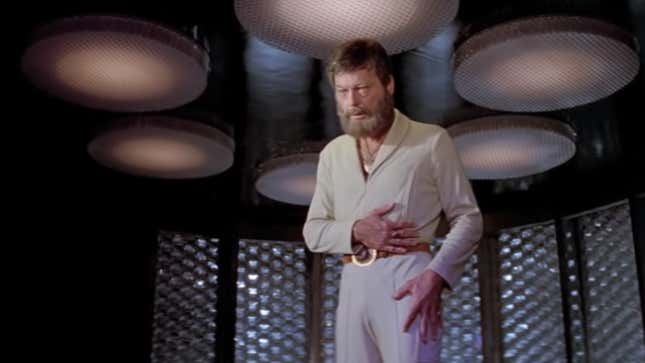
This takes 132 minutes . I cannot stress enough how too long this movie is, too meandering, too indulgent, too everything other than actually interesting.
Despite these fatal flaws, and beneath its languid pacing, The Motion Picture also speaks to the heart of what Star Trek is about; i t shows us the grand, haunting, wild and sheer weirdness of space exploration, of encountering the unknown. Perhaps not quite the boldly going of that iconic opening bit from Kirk that accompanied every episode of Star Trek , perhaps not quite even the where no one has gone before, given that this movie is essentially a remake of the season two episode “The Changeling” stretched to a breaking point. But it still invites us to indulgently revel in the beautiful spectacle of the final frontier, to evoke those feelings of Capital-R-Romantic, exploratory wanderlust. It hopes that we, like its heroes, will spend so many of its lavish special effects sequences—some more enduring than others, these days—simply staring in awe as Jerry Goldsmith’s equally awe-inspiring soundtrack blares into your ears.
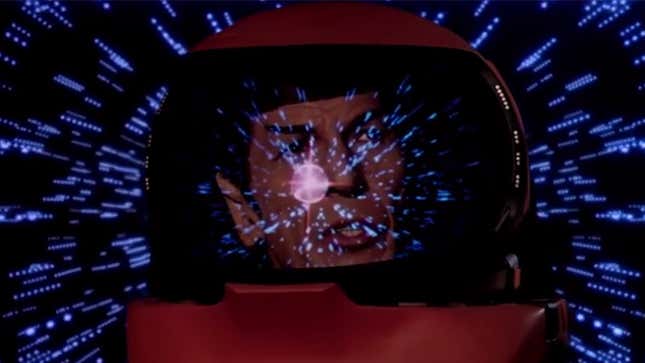
There are so many incredible images the film lingers on . The chilling displays of the mysterious cloud eradicating a Klingon scout party in the opening. Spock, heading out alone into the depths of V’Ger’s innards in search of an understanding with it. The slow unveiling of the heart of V’Ger, and the reveal of its true identity. Those glorious, glorious views of Kirk’s first return approach to the Enterprise via shuttlecraft—a sequence so delectably hedonistic it almost feels like a Playboy photoshoot for a starship—that, like the rest of the movie, goes on for a lot longer than it arguably should.
It’s in these atmospheric moments that The Motion Picture lances through the esoteric dullness of its actual plot to nail what its endless scenes of characters talking and staring at viewscreens never could: space is beautiful, and weird, and petrifying, and alluring, all at once. It’s as captivating as it is cold, as intimate as it is vast and alienating.
And yet it’s also in these moments of astounding, haunting beauty that the film still cannot escape its paradoxical existence. V’Ger’s presence is full of spectacle and unknown dread, making for all those beautifully evocative shots as the Enterprise begins to explore and probe it, but the reveal of its true identity and its intent comes so late in the film that the unknowing tease simply becomes an infuriating roadblock, one that our heroes managed to solve a third of a way through an episode of TV back when this story was still “The Changeling.” Even that iconic, beautiful sequence of Kirk and Scotty’s shuttlecraft making its way towards the drydocked Enterprise , full of fan-tingling nostalgia, thematically clashes with the argument that the film spends most of its time engaging Kirk in—that he’s no longer at home aboard it, stiffened and turned irascible by his promotion, no longer familiar with the place he most longs to be and rendered aimless by that malaise. Much like The Motion Picture itself.
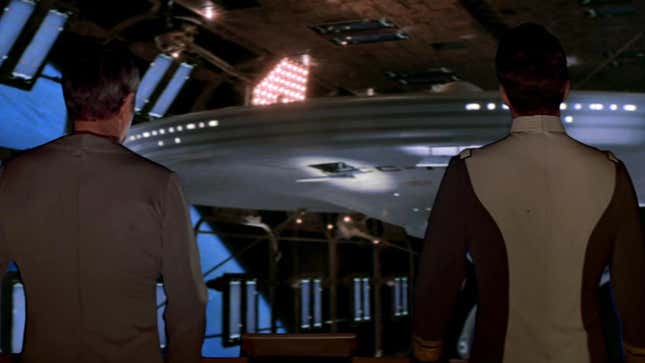
And that really is the rub of this movie, once you peel back the layer of its position in Star Trek ’s history. It’s a tight, focused hour of TV, retooled and stretched to a box office grandeur in an attempt to ape Star Wars to the point of narrative incoherence. It’s a moody, cerebral drama in a format that craves action, bursting with big ideas it incessantly talks about without ever really acting on them. It’s a nostalgic reunion of a beloved team that treats a good chunk of that team like it doesn’t really want to actually be there.
And yes, it’s incredibly beautiful to the point of indulgence, while somehow also draining the technicolor dream coat aesthetic of its TV forebear into an insipidly dull color palette (they saved all the color for the poster, ultimately the greatest thing to come out of Star Trek: The Motion Picture ). This movie is so incredibly beige —emotionally and literally, those gorgeous Starfleet uniforms of r ed, b lue, and g old swapped out for pantsuits that come in either shades of deathly pale baby blue or taupe—it almost hurts, but to even feel that hurt would be too strong a reaction to something that is so bland it’s almost like a black hole of emotion.
Yet still, sometimes, just rarely, a tiny crack of something brilliant breaks into escape velocity from that dull void. As the movie comes to an close, V’Ger is dealt with and Kirk is ready to c aptain the Enterprise on a new mission again. Ilia’s replacement at the helm, Chief DiFalco, asks him for a heading. Kirk doesn’t give her one: instead, with a wave of his hand, a twinkle in his eye, and a wry smile, he simply says “Out there. That - away .” It’s a lovely moment, as we’re treated to one final visual indulgence, a gorgeous shot of the Enterprise soaring into warp speed. Our heroes are back, at last.
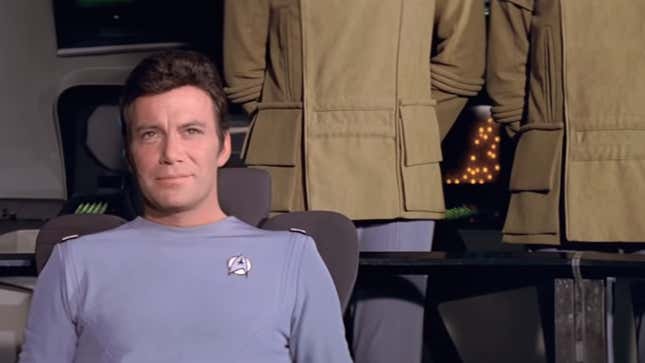
Perhaps it’s weirdly apt summation of the whole endeavo r that Star Trek: The Motion Picture takes its entire runtime to finally, finally get there.
For more, make sure you’re following us on our new Instagram @ io9dotcom .
Advertisement
- Show Spoilers
- Night Vision
- Sticky Header
- Highlight Links

Follow TV Tropes
http://tvtropes.org/pmwiki/pmwiki.php/Recap/StarTrekS2E3TheChangeling
Recap / Star Trek S2 E3 "The Changeling"
Edit locked.

Original air date: September 29, 1967
The episode starts off as most episodes start off: with the Enterprise on its way to a planet for Kirk to screw around with. Only, this time … there's no planet. The entire system they were assigned to go to has had all of its organic life forms vaporized , leading the crew to wonder just what the hell is going on. The answer comes in the form of a tiny vehicle firing massive amounts of plasma energy at the ship, resulting in a weak retaliation and the most ludicrous exchanges known to mankind:
Spock: Our shields absorbed (the) energy equivalent to 90 of our photon torpedoes . The energy used in repulsing this first attack reduced our shielding power 20% . (Kirk orders a single photon torpedoes launched, It does nothing .) Spock: No effect. The target absorbed (the) full energy of our torpedo. Kirk: [incredulous] Absorbed it? ... What could've absorbed that much energy, and survived??
Um … yeah. The Enterprise can absorb 450 torpedo hits , but Kirk is stunned when the other vehicle absorbed the detonation of one torpedo. note Either they assumed it was a spaceborne Glass Cannon , or that something as small as two meters in length shouldn't be able to withstand that kind of attack.
Anyway, Kirk orders a hail to the probe, which inexplicably stops its attacks. After some exchanges of Translator Microbes , the probe, called "Nomad", ceases hostilities, referring to Kirk as " The Creator " in the process. It's brought aboard, against the concerns of Scotty , and is let loose on the ship. This can't possibly go wrong, can it? I mean, it's not possibly like it's able or willing to Kill All Humans and — oh, wait, it's shown to have the power to annihilate an entire planet's worth of organics, and tells the crew that its mission is to "sterilize all imperfect biological organisms". Right then, moving on …
The big three converge over what exactly Nomad is and what it's doing; it seems like the probe wasn't , in fact, able or willing to cause The End of the World as We Know It , in the first place, and its creator — Jackson Roykirk — programmed it for simple deep space exploration. By its own admission, Nomad clearly had an incident with what it calls "The Other", which altered its structure and programming, causing it to become Bender's non-alcoholic and more abusive ancestor and mistaking Kirk for its builder. Unfortunately, by the time they realize this, Nomad has already been lured to the bridge by the siren's song of Uhura, which confuses it and causes it to wipe her memory when it can't discern the logic of "music". And it kills Scotty, too, when he tries to interfere, but the machine fixes him right up afterwards, so it's no big deal. Of course, with Uhura's brain now wiped, we get a hilarious re-education subplot involving her trying to read "The dog has a ball". note Unfortunately, the broadcast version of the remastered episode has severely truncated the scene where Uhura is re-learning how to read.
With time running out, and information on what happened to Nomad still scanty, Spock somehow manages to mind-meld with the thing. It turns out "The Other" is a probe called "Tan-Ru", sent by an alien society to collect and sterilize soil samples as a prelude to colonization, and they combined during a self-repair attempt into the current Nomad. How that gave it the ability to nuke a world is left to the imagination, and there is no time to speculate, as Nomad has shut down the life support systems of the ship, threatening everyone on board. After confronting the killer probe and confirming that its death orders have no loophole, Kirk does what he does best: confuse a computer to death, by dropping the Logic Bomb that Nomad isn't perfect as it mistook him for its long-dead creator. This melts down two computers — Nomad itself, and Spock's brain, as Kirk was never one for flawless logic, but luckily they're able to beam the probe off the ship before it blows itself up.
The Tropeling:
- A.I. Is a Crapshoot : Nomad, a deep-space probe, clearly had an incident with what it calls "The Other", quickly revealed to be an alien probe named Tan-Ru, which altered its structure and programming, causing it to become self-aware . Part of its new programming includes the sterilization of life as a prelude to alien colonization, corrupted from Tan-Ru's original mission. Spock: (mind-melding into a Machine Monotone ) I am Nomad. I am performing my … function. Deep emptiness … it approaches … collision … damage … blackness. … I am the Other. I am Tan-Ru … Tan-Ru … Nomad … Tan-Ru … error. Flaw. Imperfection. Must … sterilize. ( Beat ) Rebirth … we are complete … much power … gan ta nu ik-ta Tan-Ru … the Creator … instructs … search out … identify … sterilize imperfections. … We are Nomad … we are Nomad … we are complete. We are instructed … our purpose is clear … sterilize imperfections … sterilize imperfections … Nomad — sterilize — sterilize — NOMAD — STERILIZE —
- A Million Is a Statistic : A planetary population of four billion, sterilized by Nomad, isn't mentioned again in the episode.
- Alien Arts Are Appreciated : Nomad overhears Uhura singing to herself, and curiously approaches her about this unique form of "communication". The probe ultimately can't understand the idea of music and decides that it is frivolous.
- Back from the Dead : Scotty.
- Nomad claims that its mission is non-hostile, after having killed the inhabitants of four worlds .
- Spock claims that Kirk was just testing Nomad's memory banks, because he realised that Nomad's assumption that Kirk was The Creator was the only thing stopping it from 'purging' the 'biological infestation' on Enterprise .
- Blue-and-Orange Morality : Nomad is simply a computer carrying out (the garbled remnants of) its programming and that of Tan-Ru.
- Bread, Eggs, Breaded Eggs : Nomad and Tan-Ru's programming is a rare dramatic example. Nomad's orders: Seek out new life forms. Tan-Ru's orders: Collect soil samples and sterilize them. Final result : Seek out and sterilize imperfect life forms.
- Continuity Nod : The song Uhura sings is "Beyond Antares", which she'd sung in full back in "The Conscience of the King" .
- Cooldown Hug : Kirk gives Spock one after a Mind Meld goes bad.
- Creator Cameo : Marc Daniels, the director of the episode, appears as the photo of Jackson Roykirk (at 17 minutes and 48 seconds into the episode, to be precise).
- Death Is Cheap : Scotty is killed by Nomad, then revived by it in a matter of minutes no worse for wear.
- Early-Installment Weirdness : The Enterprise is stated as passing warp 10 and then warp 15. Later series would establish warp 10 as the absolute maximum way to quantify speed and as infinite speed . This has led to fanon that in between TOS & TNG, the method of calculating warp speed was changed.
- Easy Amnesia : Nomad claims he's completely erased Uhura's mind, yet she is nearly "re-educated" by the end of the episode. It implies that Nomad didn't actually erase Uhura's memories, but simply blocked her access to them, another strike against the machine's supposed "perfection".
- "Eureka!" Moment : In the final confrontation with Nomad, Kirk, after confirming several times that Nomad will "sterilize" anything that is imperfect or in error without exception, decides to convince the probe that it itself is imperfect, and by its own logic should be eliminated .
- Exact Words : Kirk asks Nomad if he destroyed the system where they found him. He answers truthfully, "Not the 'system', but the biological infestation ."
- Fusion Dance : Spock's mind-meld with Nomad reveals that, after their collision long ago, Nomad and Tan-Ru underwent one of these as they merged and self-repaired. The "new" Nomad kept the Earth probe's name, the alien probe's power and hardware, and a blend of each other's programming (settling on "search out … identify … sterilize imperfections ").
- Gone Horribly Right : Nomad upgrades the Enterprise ' s engines, causing it to reach warp 10 and then warp 15 . However, the ship starts to break down because it is not designed to travel that fast, and so Kirk demands the upgrades reversed.
- Hates Being Touched : Nomad. Trying to touch it is not a good idea. Whether or not this is because it interprets any contact as an attack is not known. It will, however, allow itself to be touched (e.g. by Spock) if Kirk orders it to do so, because it believes that Kirk is its Creator.
- I'm Standing Right Here : Bones is clearly offended when Nomad says that he "functions erratically".
- "It" Is Dehumanizing : Nomad refers to everyone, human or Vulcan, as a "unit".
- It Runs on Nonsensoleum : How Nomad packs so much power into a couple-metres-long probe is never really explained.
- Jewish Mother : Invoked by Kirk, with tongue firmly in cheek, mock-mourning the probe that thought Kirk had created it: "You saw what it did to Scotty. What a doctor it would have made. [beat] My son, the doctor."
- Just Testing You : After Kirk asks Nomad why Nomad refers to him as "The Creator", Spock quickly interrupts, telling Nomad that "The Creator was just testing your memory banks".
- Little "No" : Spock: My congratulations, Captain. A dazzling display of logic. Kirk: You didn't think I had it in me, did you, Spock? Spock: No, sir.
- In the climax, Kirk convinces Nomad that it is itself imperfect by revealing that its creator, Jackson Roykirk, is dead and that Nomad mistook Kirk for him. Then he says that Nomad made another error by not discovering the first error, and then committed a third error by not sterilizing itself after the first two. This sends Nomad into a Villainous Breakdown that leads to its self-destruction.
- Also subverted earlier in the episode. Nomad came to see that Kirk (who it still thought was its Creator) also qualified as an "imperfect" being. When Kirk asked it how an imperfect being could have created a perfect machine, Nomad simply concluded that it had no idea.
- Machine Monotone : Spock slowly takes on this speech pattern as he mind-melds with Nomad, and even as he backs away from the probe, showing the gradual Mind Rape inflicted by the probe's powerful artificial intelligence.
- Spock says "… Nomad … sterilize …" over and over again after a mind meld gone wrong with the probe NOMAD.
- Nomad, after Kirk gives it a Logic Bomb , causing the probe to repeatedly shout "error", "analyze", "examine", "faulty" and so on in a progressively higher and more distorted tone until it self-destructs.
- Mechanical Abomination : Once a simple exploration device, Nomad now wields both the power to raze worlds and a vast, warped intelligence that drives it to kill.
- Mistaken Identity : Nomad thinks Kirk is his creator, Dr. Jackson Roykirk.
- Oh, Crap! : When Kirk, angry over Nomad referring to the redshirts he "sterilized" as "biological units", answers, "I'm a biological unit and I created you!" This confuses Nomad, and Kirk realizes that he was foolish to say it, as it now leaves everyone open to "sterilization".
- Only Mostly Dead : Scotty, but he gets better thanks to Nomad's intervention.
- Only Sane Man : Scotty is the only crew member who objects to bringing a planet-sterilizing superweapon aboard the ship. McCoy , to an extent, is also all kinds of apprehensive.
- Pintsized Powerhouse : Nomad, five hundred kilograms and a metre or two long, can knock out the Enterprise shields with just three blasts.
- Scotty is zapped by Nomad but revived, whereas every other Red Shirt it attacks is completely vaporized.
- Nurse Chapel somehow survives trying to stop Nomad from accessing Kirk's medical records as well, being only stunned. It happened off screen, so we don't know exactly how threatening she was to Nomad.
- Kirk also reveals at one point that he is a "biological unit" and thus imperfect, but his status as the Creator in Nomad's mind means Nomad never seriously tries to "sterilize" him.
- Poke in the Third Eye : The mind-meld with the probe's artificial mind goes seriously wrong, to the point that Spock is sent into a near-catatonic state as Nomad takes control of the meld. Kirk, who Nomad fortunately respects as its "Creator", has to order Nomad to let go of Spock and drag the Vulcan out into the corridor to recover.
- P.O.V. Cam : We get a couple of them from Nomad. Once when he follows a leery Bones to sickbay, and once when he walks off with some disgruntled guards.
- Reaction Shot : When Kirk drops the Logic Bomb , the camera briefly cuts to Nomad; it doesn't visibly react, but one can easily imagine that it's thinking "WTF?" after the Wham Line .
- Red Shirt : One of the highest body counts in the series, as Nomad vaporizes four security guards when he breaks confinement and kills (or at least incapacitates) two others.
- Robo Speak : This is how Nomad talks.
- Nomad mistook James T. Kirk for Jackson Roy kirk , his creator. Strike one.
- Nomad did not immediately discover his mistake and imperfection. Strike two.
- Nomad did not correct by sterilization. Strike THREE and yer' OUT!
- Screen Shake : And it's a doozy, with the entire bridge crew hurled back and forth as Nomad's opening shot hits the shields.
- Significant Name Overlap : It's downplayed, but James T. Kirk and Jackson Roykirk have some naming similarities, such as their first initials and the last (or all) four letters of their surnames. This is enough for Nomad, with its garbled programming, to mistake Kirk for Roykirk as its "Creator", and eventually lead to its own self-destruction after the mistake is clearly identified.
- Snap Back : Uhura is back to normal by the next episode, despite last being seen being taught to read again and only being able to speak Swahili. An earlier draft of the script had Nomad explaining that it had not purged her brain completely — her memories and experiences were intact, but her ability to express language was wiped. This line was probably cut for time. They probably taught her Swahili first because it was her original language. (By the way, she first says Sikumbuka — "I can't remember" — then ina mbwa ni tufe, "the dog has a ball.") The James Blish novelization still has this version.
- Speaks in Binary : Nomad while in space. It later changes to a mathematical message requesting language equivalence.
- This Cannot Be! : Kirk when told the entire population of the system has been destroyed, then when told that Nomad just absorbed the energy of a detonating photon torpedo with no damage.
- Title Drop : When Kirk discusses with Spock the old notion of a changeling — a creature left in place of a baby by the Fair Folk .
- Too Dumb to Live : You would think that after the deaths of the first couple of redshirts , the others would quit firing on the damn thing. But they don't.
- Touched by Vorlons : Nomad's destructive abilities were enhanced after the impact with an alien probe.
- Unexplained Recovery : Scott was tempting fate, wearing that red shirt in every episode. He got better, but at least four other Redshirts weren't so lucky.
- Villainous Breakdown : Kirk's Logic Bomb to Nomad leaves the probe shaking and erratically shouting "Error", "Analyze", "Must sterilize" and variations thereof in a rising and distorted voice, as it builds up to self-destruct.
- Weapon of Mass Destruction : Nomad counts as one, after its fusion with Tan-Ru.
- We Come in Peace — Shoot to Kill : Kirk assures Nomad that they mean no harm, moments after firing a photon torpedo at it. And then Nomad, in a major Refuge in Audacity moment, states that its own mission is non-hostile, moments after pummeling the Enterprise with powerful energy bolts.
- What Measure Is a Non-Human? : Inverted. Nomad wants to kill anything that's too human. Spock is spared because he is so much more "orderly" than the human crew members. Spock seems almost flattered to be described as such.
- Woobie, Destroyer of Worlds : Aw, he's just a little lost robot doing what he thinks he was programmed to do!
- Writers Cannot Do Math : The range to Nomad when it is firing at Enterprise is given as 90,000 km, and the plasma bolts are travelling at Warp 15. They shouldn't be taking several seconds to impact, they should be covering that distance in a tiny fraction of a second.
Video Example(s):
Captain kirk and nomad.
Captain Kirk exploits Nomad's belief that it is perfect and programming to eliminate imperfections by pointing out something it overlooked: In mistaking Kirk for its creator, it is itself imperfect, and thus must eliminate itself.
Example of: Logic Bomb
- Star Trek S2 E2 "Who Mourns for Adonais?"
- Recap/Star Trek: The Original Series
- Star Trek S2 E4 "Mirror, Mirror"
Important Links
- Action Adventure
- Commercials
- Crime & Punishment
- Professional Wrestling
- Speculative Fiction
- Sports Story
- Animation (Western)
- Music And Sound Effects
- Print Media
- Sequential Art
- Tabletop Games
- Applied Phlebotinum
- Characterization
- Characters As Device
- Narrative Devices
- British Telly
- The Contributors
- Creator Speak
- Derivative Works
- Laws And Formulas
- Show Business
- Split Personality
- Truth And Lies
- Truth In Television
- Fate And Prophecy
- Edit Reasons
- Isolated Pages
- Images List
- Recent Videos
- Crowner Activity
- Un-typed Pages
- Recent Page Type Changes
- Trope Entry
- Character Sheet
- Playing With
- Creating New Redirects
- Cross Wicking
- Tips for Editing
- Text Formatting Rules
- Handling Spoilers
- Administrivia
- Trope Repair Shop
- Image Pickin'
Advertisement:
How well does it match the trope?
Example of:
Media sources:
11,241--> Report

Changelings In Star Trek: Discovery - Did Season 1 Burnham Know About DS9's Villains?
WARNING: This article contains SPOILERS for Star Trek: Discovery season 5, episode 4, "Face the Strange" Mutineer Michael Burnham (Sonequa Martin-Green) calls her future self a "shapeshifter" during Star Trek: Discovery season 5, episode 4, but does this mean that she's aware of Star Trek: Deep Space Nine 's Changeling villains? In Discovery season 5, episode 4, "Face the Strange", Burnham, Commander Rayner (Callum Keith Rennie) and Commander Paul Stamets (Anthony Rapp) are thrown backwards and forwards in time by a Krenim time bug. To return to the 32nd century, Burnham is forced to fight her younger self, who believes that she's a shapeshifting infiltrator determined to sabotage the USS Discovery .
Star Trek: Discovery season 5, episode 4, "Face the Strange" was written by Sean Cochran and directed by Lee Rose.
Changeling infiltrators caused many problems for Captain Benjamin Sisko (Avery Brooks) and the crew of Deep Space Nine during the Dominion War. However, DS9 's conflict with the Dominion and its Changeling Founders took place a century after the climactic scenes of Discovery season 5, episode 4 , during which the Federation was at war with the Klingon Empire. This makes it unlikely, but not impossible, for the season 1 version of Michael Burnham to be referring to one of DS9 's Changelings in Star Trek: Discovery .
Every Changeling In DS9 (Besides Odo)
Season 1 burnham probably isn't referring to ds9's changelings in discovery.
Official First Contact with the Changelings didn't take place until the 24th century , in Star Trek: Deep Space Nine 's two-part season 3 premiere "The Search". This means that it's unlikely that Season 1 Burnham wasn't referring to a DS9 Changeling while trying to foil Season 5 Burnham, Rayner, and Stamets' "sabotage" in Star Trek: Discovery . However, DS9 established that the Changelings had been exploring the galaxy for eons before the 24th century . This creates the outside chance that the season 1 version of Burnham had encountered one of DS9 's Changelings prior to joining the USS Discovery.
The Female Changeling, the species' spokesperson, was played by Salome Jens, who also played the Progenitor in Star Trek: The Next Generation 's "The Chase", to which Star Trek: Discovery season 5 is a sequel.
Constable Odo (Rene Auberjonois) was one of 100 Changelings that were sent out into the galaxy, " centuries ago ". Odo only ever met one of the hundred Changelings, Laas (J.G. Hertzler), who arrived on the planet Varala in the 22nd century, 100 years before Star Trek: Discovery's timeline begins. Odo made it further than Laas, arriving in the Alpha Quadrant, where he was discovered by Bajoran scientists. It's possible, therefore, that other members of the Hundred Changelings were encountered by Burnham while she served aboard the USS Shenzhou. Alternatively, Burnham was referring to one of the many Star Trek shapeshifters that aren't Changelings .
Star Trek Shapeshifters That Aren't Changelings
Star Trek: Deep Space Nine 's Changelings are just one of many aliens that have the ability to change their shape to imitate other forms . One of the most memorable shape-shifting alien species in the Star Trek canon was the Chameleoid, Marcia (Iman), who both kissed and impersonated Captain James T. Kirk (William Shatner) in Star Trek VI: The Undiscovered Country . Another shape-shifting alien with romantic intentions was Species 8472 from Star Trek: Voyager , one of whom impersonated Valerie Archer (Kate Vernon) and romanced Commander Chakotay (Robert Beltran).
Shape-shifting could even be taught, as seen in the Star Trek: The Original Series episode "Whom Gods Destroy" , in which Garth of Izar (Steve Ihnat) showed off the abilities he learned from the Antos natives. The Traveler from Star Trek: The Next Generation also had shapeshifting abilities, impersonating Wesley Crusher's father Jack in "Journey's End". Some members of Star Trek: Enterprise 's Suliban species had technology that enabled them to shape-shift, enabling them to infiltrate various situations. With so many shapeshifters in the Star Trek universe, it's no wonder that Burnham was so paranoid in Star Trek: Discovery season 5, episode 4.
Star Trek: Discovery streams Thursdays on Paramount+.
Star Trek: Discovery
Star Trek: Discovery is an entry in the legendary Sci-Fi franchise, set ten years before the original Star Trek series events. The show centers around Commander Michael Burnham, assigned to the USS Discovery, where the crew attempts to prevent a Klingon war while traveling through the vast reaches of space.
Star Trek: Deep Space Nine
Star Trek: Deep Space Nine, also known as DS9, is the fourth series in the long-running Sci-Fi franchise, Star Trek. DS9 was created by Rick Berman and Michael Piller, and stars Avery Brooks, René Auberjonois, Terry Farrell, and Cirroc Lofton. This particular series follows a group of individuals in a space station near a planet called Bajor.
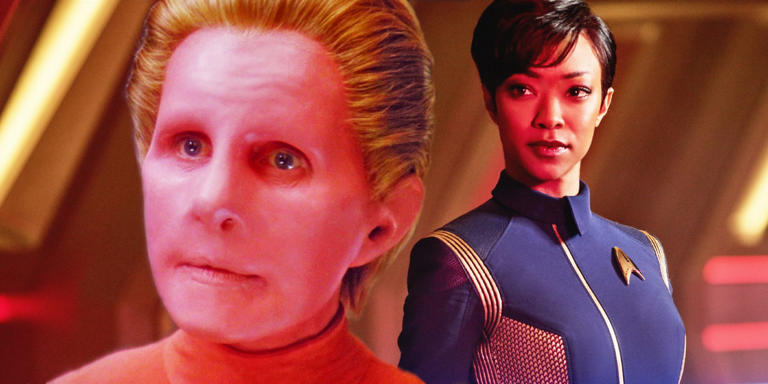

IMAGES
VIDEO
COMMENTS
The original Star Trek series episode TOS2x08: The Changeling features an old Earth probe that was presumed lost, returns and on its way to discover its point of origin sterilizes planets it find to be imperfect. Kirk is even called "the Creator". Star Trek: The Motion Picture features an old Earth probe, presumed lost, that returns to Earth to find its Creator.
The Changelings were shapeshifting lifeforms (in their natural state a liquid) native to the Gamma Quadrant of the Milky Way Galaxy. They were the creators and rulers of the Dominion, whose subject races knew them as the semi-mythical Founders. Most Changelings existed as an amalgamated mass known as the Great Link. The natural form of a Changeling was a viscous orange liquid containing a ...
And yes, even though Star Trek: The Motion Picture is in some ways a rewrite of the original series episode "The Changeling," it's much more expansive and even cosmic in its implications.
"The Changeling" is the third episode of the second season of the American science fiction television series Star Trek. Written by John Meredyth Lucas and directed by Marc Daniels, it was first broadcast on September 29, 1967.. The crew of the USS Enterprise deals with a life-destroying space probe originally launched from Earth. The plot contains similarities to the later 1979 Star Trek film.
For this reason, some fans have appended to Star Trek: The Motion Picture the pun subtitle "Where Nomad Has Gone Before." (Star Trek: The Original Series 365, p. 188) ... a Roddenberry Star Trek podcast " The Changeling" at the Internet Movie Database; Previous episode produced: " Wolf in the Fold" Star Trek: The Original Series Season 2:
The Great Link (or The Link) was the intermingling of many Changelings in their natural liquid form, and the foundation of their society, providing meaning for the Changelings' existence. (DS9: "The Search, Part II") As the home of the Founders, the Link was effectively the "capital" of the Dominion. For millennia, the Link was located on a rogue planet within the Omarion Nebula, until it was ...
The Changeling: Directed by Marc Daniels. With William Shatner, Leonard Nimoy, DeForest Kelley, James Doohan. A powerful artificially intelligent Earth probe, with a murderously twisted imperative, comes aboard the Enterprise and mistakes Capt. Kirk for its creator.
Star Trek: The Motion Picture is a 1979 American science fiction film directed by Robert Wise. The Motion Picture is based on and stars the cast of the 1966-1969 television series Star Trek created by Gene Roddenberry, who serves as producer.In the film, set in the 2270s, a mysterious and powerful alien cloud known as V'Ger approaches Earth, destroying everything in its path.
Star Trek: The Original Series "The Changeling" ... While "Star Trek The Motion Picture" tells this story as an epic Heart of Darkness journey into the awesome unknown, keeping the big reveal secret until the end, the TOS source episode relies more on character and tension to get the job done. The coincidence that saves the ship here at the ...
Even though this episode is decidedly mixed, it still ended up inspiring the creation of V'Ger for Star Trek The Motion Picture (and foreshadowed the perfection-loving Borg too).
Okay, "template" may be a slight exaggeration. However, you can definitely feel the influence of The Changeling on Star Trek: The Motion Picture.However, that may simply be because the script to The Changeling hits quite heavily on some of Gene Roddenberry's pet themes.It has a villainous robot outwitted by emotional humans, Kirk besting a god-like entity, and larger philosophical ...
A place to discuss Star Wars with a huge emphasis on positivity. Criticism of any content is allowed, but do so respectfully towards the creators as well as the fans. The Cantina is here for us to celebrate what we love about Star Wars. #SWC has joined other subreddits in protest against the recently announced API changes.
Star Trek: The Motion Picture returned to the big screen this week, with showings on Sunday, May 22, Monday, May 23, and Wednesday, May 25 by Fathom Events. Tickets are on sale now at fathomevents ...
Those who wish to view a more succinct presentation of Star Trek: The Motion Picture may enjoy this episode for its shared premise with the aforementioned film, while others will admire Kirk's ingenious method of exposing the illogic in Nomad's mission to cleanse the universe of imperfection. Overall Quality: 9/10.
"The Changeling" introduced a new kind of being into Star Trek's mythic universe; the sentient machine. In our modern myth-making, the machine has become the...
© 2023 CBS Studios Inc., Paramount Pictures Corporation, and CBS Interactive Inc., Paramount companies. STAR TREK and related marks are trademarks of CBS Studios Inc.
Not a retelling but very similar, enough so that it earned TMP the nickname "Where Nomad has gone before". No. It was recycled from a pilot script called "In Thy Image" which was written for the cancelled Star Trek Phase II series, well before the movie, and after the original series. The parallels are fairly numerous.
Aside from some interesting thematic and plot-related similarities to The Motion Picture, The Changeling doesn't offer anything particularly unique or exciting. Read more at ... 3 = Good! Generally enjoyable, worth watching if new to Star Trek. 4 = Great! An example of why we love Star Trek. 5 = One of the best. A classic. My Tweets Subscribe ...
Review Text. The recent DVD release of Star Trek: The Motion Picture — The Director's Edition represents a revisit to a piece of the Trek canon that these days seems known more for its place in Trek turning-point history than for its value as a feature film. Among fans and critics, ST:TMP is not often highly respected in the ranks of the Trek films. In terms of tone, it certainly stands out ...
The Changeling is the episode that formed the basis for Star Trek: The Motion Picture (1979), which also revolved around a deep space probe encountering alien technology. Unlike that pretentious, overblown, drawn-out, mega-budget disappointment of a movie, the original TV show is actually very entertaining - sometimes, less is more.
Forty years ago a landmark moment in Star Trek's history arrived, in the form of Star Trek: The Motion Picture. It's an important chapter in the series' survival, the turning point from ...
Recap / Star Trek S2 E3 "The Changeling". Recap /. Star Trek S2 E3 "The Changeling". Hey, that doesn't look like one of the Founders. Original air date: September 29, 1967. The episode starts off as most episodes start off: with the Enterprise on its way to a planet for Kirk to screw around with. Only, this time … there's no planet.
Trailer for the second season episode of "Star Trek" called "The Changeling." An episode much like "Star Trek: The Motion Picture."
Official First Contact with the Changelings didn't take place until the 24th century, in Star Trek: Deep Space Nine's two-part season 3 premiere "The Search".This means that it's unlikely that ...